This guide will explore what to plant in May, providing detailed tips on the best practices, care, and local considerations for successfully growing a variety of plants.
Vegetables To Plant
May provides optimal conditions for planting a variety of vegetables within California’s diverse regions. Here are ten recommended vegetables to cultivate:
Tomatoes
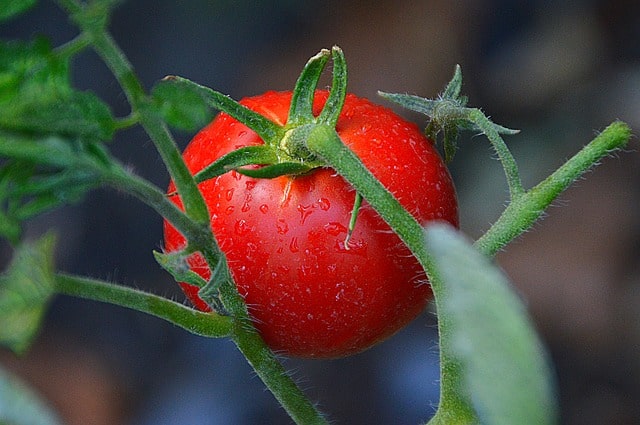
Tomatoes are a beloved garden staple in California, thriving in the long, warm growing season that spans from late spring through summer. Known for their versatility, tomatoes can be used in countless dishes. To achieve the best harvest, it’s crucial to start with healthy seedlings, ideally around 6-8 weeks old, which can be transplanted outdoors in mid-to-late May after the threat of frost has diminished. Providing your tomato plants with rich, well-draining soil that has been amended with compost will enhance their growth. Make sure to choose a sunny location with at least 6-8 hours of sunlight daily. Water them deeply at the base to prevent diseases, and consider using stakes or cages for support as they grow.
Varieties: California is well-suited for many tomato varieties, including Early Girl, Brandywine, Roma, and San Marzano. Consider heirloom varieties for superior flavor.
Soil Requirements: Tomatoes prefer well-drained, fertile soil with a pH of 6.0 to 6.8. Amend with compost to enrich nutrient availability.
Transplanting: Space tomatoes 18-24 inches apart in rows. When transplanting, bury the stem deeper than the original soil line to encourage robust rooting.
Watering: Water deeply at the base once or twice a week, particularly during dry spells. Drip irrigation is ideal, as it minimizes water loss through evaporation.
Mulching: Apply mulch to retain moisture, suppress weeds, and regulate soil temperatures. Pine needles or straw work particularly well.
Harvesting: Monitor for ripeness; typically, tomatoes are ready when they show full color and sink slightly to touch. Picking them regularly encourages further fruit set.
Peppers

Peppers are another favorite in California gardens, offering a spectrum of flavors from sweet to spicy. Like tomatoes, they thrive in warm weather, making May an ideal month for planting. Begin by selecting high-quality seedlings or starting seeds indoors 8-10 weeks before the last frost. When transplanting in May, place your pepper plants in a sunny spot that gets at least 6 hours of sunlight daily and ensure soil is well-drained and rich in organic matter. Space them generously about 18 inches apart to allow room for growth. Regular watering is essential, especially as flowers develop, and avoid splashing water on the foliage to reduce the risk of fungal diseases. A balanced fertilizer can help boost growth as well.
Varieties: California’s warm climate supports various peppers, such as Bell, Jalapeño, Anaheim, and Habanero. Select varieties based on your flavor preferences.
Soil Conditions: Peppers thrive in rich, well-draining soil. Prepare the soil with organic compost to ensure they receive ample nutrients.
Planting Depth: Space plants 18-24 inches apart to provide adequate air circulation. They enjoy slightly warmer temperatures, so transplant in late May if started indoors.
Watering: Keep the soil consistently moist, especially during flowering and fruit development. Avoid overhead watering to reduce the risk of disease.
Fertilization: Use a balanced fertilizer once they start flowering, promoting fruit set. Observe the plant’s growth and adjust fertilizer applications as needed.
Pest Management: Monitor for common pests like aphids and spider mites. Horticultural soap or neem oil can be effective organic solutions.
Cucumbers
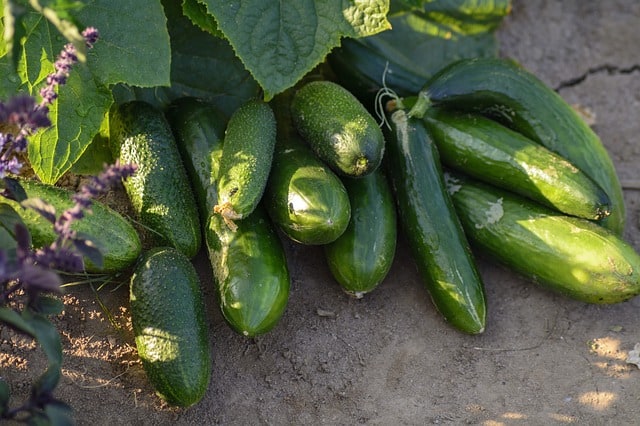
Cucumbers are a refreshing summer vegetable that enjoys the warm temperatures of California in May. When planting, select fast-growing varieties like Armenian or English cucumbers for delicious, tender fruits. You can either sow seeds directly into the garden or start indoors, but ensure they’re planted after the last frost date. Cucumbers thrive in full sun, so choose a well-draining spot that receives at least 6-8 hours of sunlight daily. Plant seeds about 1 inch deep and space them appropriately, depending on whether you’re growing bush or vining types. Regular, deep watering will maintain soil moisture, particularly in the heat, and consider using a trellis for vining varieties to maximize space and promote healthy airflow.
Varieties: Choose from slicing cucumbers, such as Armenian or English varieties, or pickling types like Kirby. Consider whether you want a compact or vining variety.
Soil Preparation: Cucumbers prefer rich, well-drained soils. Work in organic matter to enhance soil structure.
Planting Technique: Sow seeds 1 inch deep in groups of 2-3 within rows, spacing about 1 foot apart. If starting indoors, transplant when seedlings are 3-4 inches tall after the last frost.
Watering Needs: Cucumbers require consistent moisture, especially during fruit development. Water at the roots to prevent water stress or diseases like powdery mildew.
Support Structures: Use cages or trellises for vining types to maximize space and air circulation, improving overall growth and fruit quality.
Timing for Harvest: Harvest cucumbers regularly when they’re young and tender to promote additional fruit production.
Zucchini
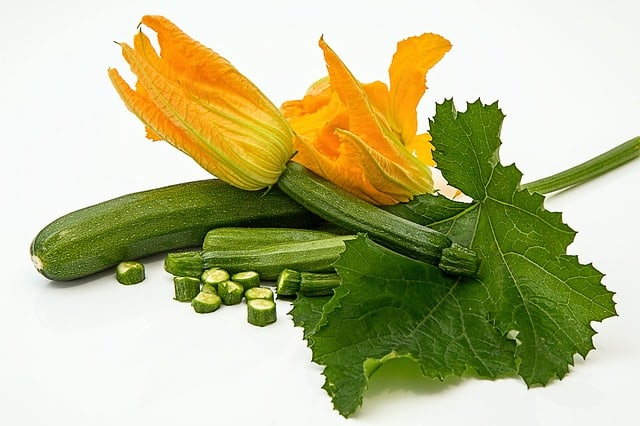
Zucchini is a popular summer squash that reaches maturity quickly, providing fresh produce for your meals. May is the perfect month to plant zucchini seeds directly into the garden, as the warmer soil fosters quick germination and growth. Find a sunny spot in your garden with well-draining soil, and prepare it by mixing in compost for added nutrients. Plant seeds 1 inch deep, spacing them at least 2-3 feet apart, as zucchini plants can spread significantly. Water consistently, aiming for deep irrigation at the base to encourage strong root development, especially during flowering. Regular harvesting of zucchini will not only provide you with fresh vegetables but will also stimulate the plant to produce even more fruit.
Varieties: Common varieties include Green Zucchini, Yellow Squash, and Round Zucchini. Each offers various culinary advantages.
Soil Preparation: Enrich the planting site with compost to ensure a fertile environment. Zucchini performs best in loamy, well-draining soils.
Spacing: Provide a spacing of 3-4 feet between plants, allowing space for sprawling growth. Consider utilizing a raised garden bed to improve drainage.
Watering: Water consistently, aiming for 1 inch per week, particularly during dry spells. Allow the top inch of soil to dry out between sessions to prevent rot.
Pest Management: Watch out for common pests, such as squash bugs and cucumber beetles, using row covers early in the season to prevent infestations.
Culinary Uses: Zucchini can be eaten raw, grilled, or sautéed and is great for recipes like zucchini bread or ratatouille.
Beans
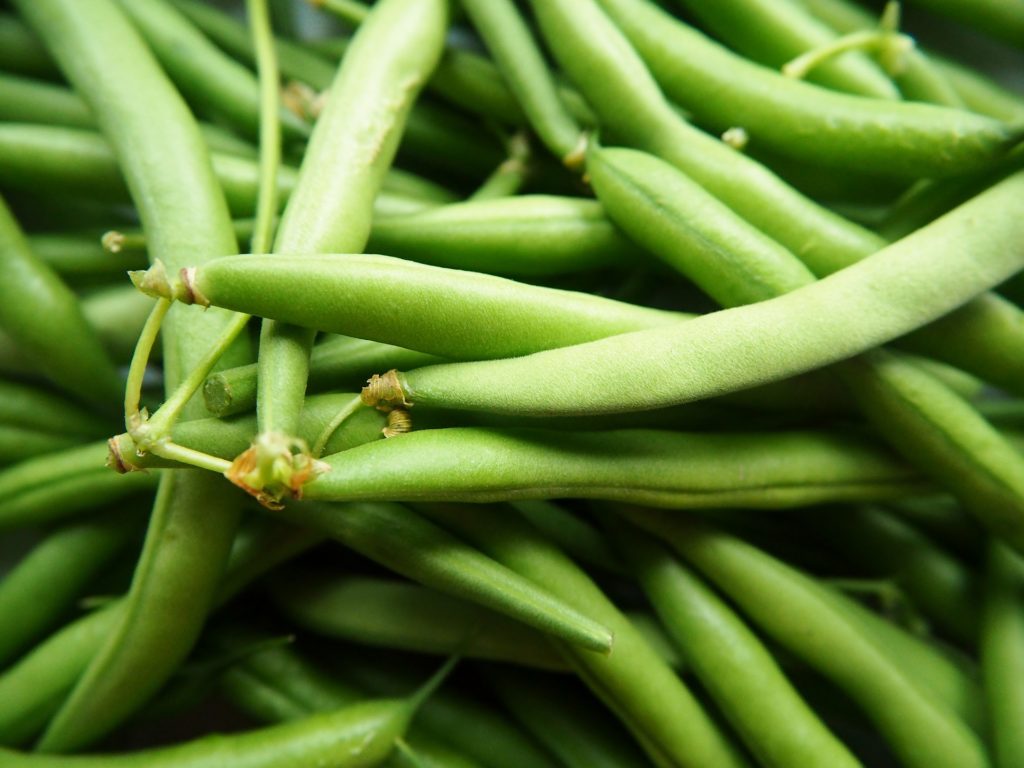
Beans are nitrogen-fixing plants that not only contribute to soil health but also yield delicious harvests for your kitchen. With May’s warm weather, it is an excellent time to plant both bush and pole bean varieties. Beans are typically direct-sown, and you should choose a sunny spot with well-draining soil enriched with organic matter. Plant seeds about 1-2 inches deep, with bush beans spaced 3-4 inches apart and pole beans positioned to climb on trellises. Water them thoroughly after sowing and maintain soil moisture but avoid overwatering once they are established. Beans thrive on consistency, so regular watering during flowering and pod development will ensure a bountiful yield.
Varieties: Both bush beans and pole beans thrive well in California. Popular choices include Blue Lake (bush) and Kentucky Wonder (pole).
Soil Preparation: Beans prefer well-drained soil enriched with organic substances. Avoid heavy fertilizers, as beans thrive in average soil fertility.
Planting Technique: Sow seeds 1-2 inches deep directly in the garden or indoor starter pots. Space bush beans about 2-4 inches apart and pole beans along trellises or supports.
Watering Needs: Watering is crucial during germination and the development of pods but decrease as the plant matures. Allow the topsoil to dry out between sessions.
Companion Planting: Beans are great companions to corn since they climb up the stalks, but avoid planting near onions, which can inhibit growth.
Harvesting: Pick beans regularly, preferably before they swell fully; this encourages new growth and extends the harvest period.
Corn
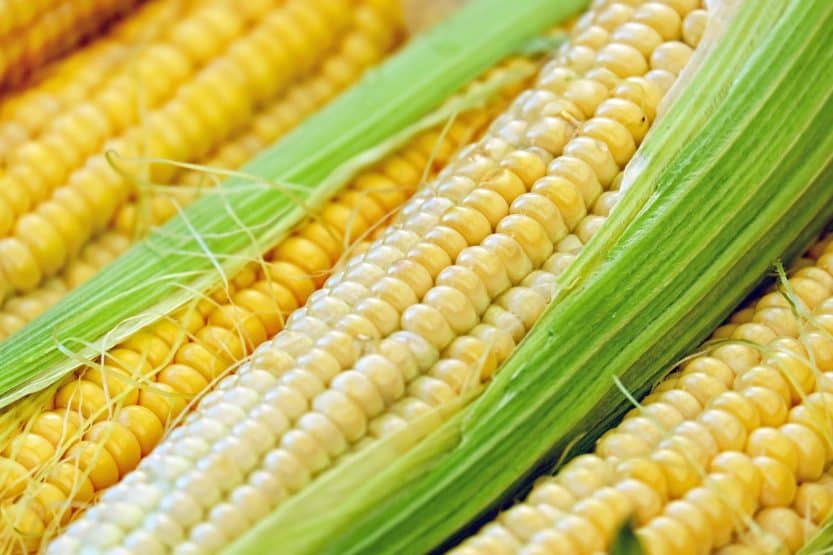
Corn requires ample space, warmth, and sunlight for healthy growth, making it a favorite among gardeners throughout California. May provides the ideal conditions for planting this summer crop. For sweet corn, choose a sunny location with well-draining, nutrient-rich soil; it’s essential to prepare the soil well in advance by incorporating compost. Sow seeds about 1-2 inches deep, spacing them 6-8 inches apart in blocks rather than rows to improve pollination. Consistent watering is crucial, particularly during the silking and ear development stages. Monitor for pests like corn earworms and use organic methods if necessary. Harvest your corn when the ears are plump and the silks turn brown for delicious, fresh corn on the cob.
Varieties: Sweet corn is a popular choice. Varieties to consider include Silver Queen for bi-color corn or Golden Bantam for heirloom flavor.
Soil Preparation: Corn prefers fertile, well-drained soil with a good amount of organic matter. Adding compost can improve soil quality significantly.
Spacing: Plant seeds 1-2 inches deep and 6-8 inches apart. To improve pollination, plant in blocks rather than rows.
Watering Needs: Ensure consistent moisture, aiming for at least 1-2 inches of water per week, particularly during silking.
Pest Awareness: Monitor crops for pests, including corn earworms and root maggots. Row covers can also offer protection early in the season.
Timing for Harvest: Harvest corn when the silks turn brown and kernels are plump. Test for readiness by checking the kernels for milky fluid.
Squash
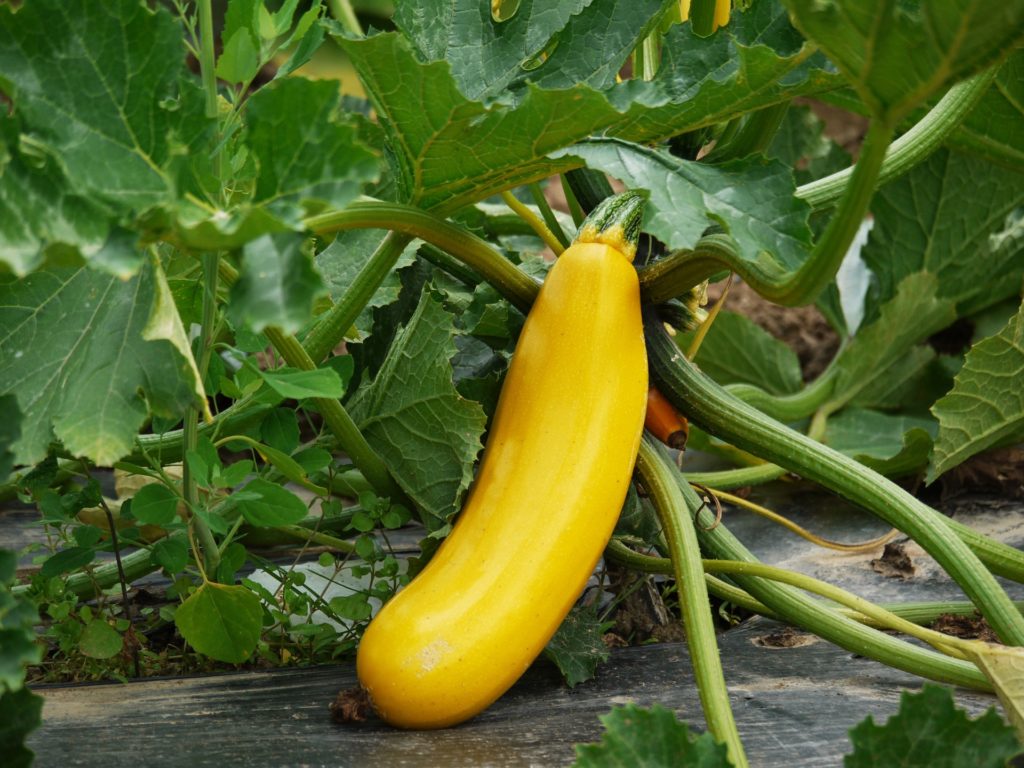
Squash includes both summer and winter varieties, each with unique characteristics. May is an excellent time for planting squash seeds as soil temperatures warm. Select your favorite varieties—zucchini and yellow squash are popular summer choices, while butternut and acorn squash are enjoyable in winter kitchens. Plant seeds directly in well-drained, nutrient-rich soil at a depth of about 1 inch, spacing them based on their type; summer varieties should be spaced 2-3 feet apart. Water regularly to keep the soil consistently moist, particularly during flowering, and use organic mulch to retain soil moisture. Regular harvesting of summer squash will prompt the plant to produce more.
Varieties: For summer squash, try varieties like Patty Pan or Yellow Squash; for winter squash, consider Butternut or Acorn.
Soil Preparation: Ensure fertile, well-drained soil with plenty of organic compost mixed in.
Planting Technique: Direct sow seeds about 1 inch deep, spacing summer squash about 2-3 feet apart, and winter squash 4-6 feet apart.
Watering Needs: Water regularly, aiming for 1 inch per week, particularly during dry spells. Allow the top inch of soil to dry out between sessions to prevent rot.
Pest Management: Monitor for common pests, such as squash bugs and cucumber beetles, using row covers early in the season to prevent infestations.
Carrots
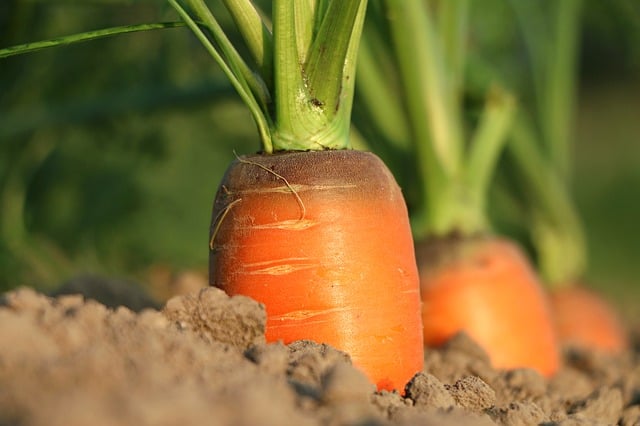
Carrots are a nutrient-rich root vegetable that thrives in cooler soil temperatures, making May an excellent time for planting in coastal and northern regions of California. Prepare a well-loosened, sandy soil free of rocks, as compacted soil can hinder root development. Sow carrot seeds directly about ¼ inch deep, spacing them 1-2 inches apart. Keep the soil consistently moist during germination, as carrots can take 14-21 days to sprout. Thinning seedlings to 2-3 inches apart helps ensure sufficient room for proper growth. Harvest when the roots reach about 1-2 inches in diameter for the best flavor and texture.
Soil Requirements: Carrots thrive best in sandy or loamy soil that is loose and well-drained. Loosen the soil to 12 inches deep before planting.
Sowing Depth: Carrot seeds should be sown directly into the garden bed, about ¼ inch deep.
Watering Needs: Regular moisture is key; keep the soil evenly moist but not saturated during germination.
Thinning: Once seedlings emerge, thin them to 2-3 inches apart to allow for proper root development and prevent overcrowding.
Harvesting Timing: Carrots can be harvested when they reach a desirable size. Pull gently to avoid damaging other roots.
Storage Tips: Store harvested carrots in a cool, dark place; they store well for several weeks.
Beets
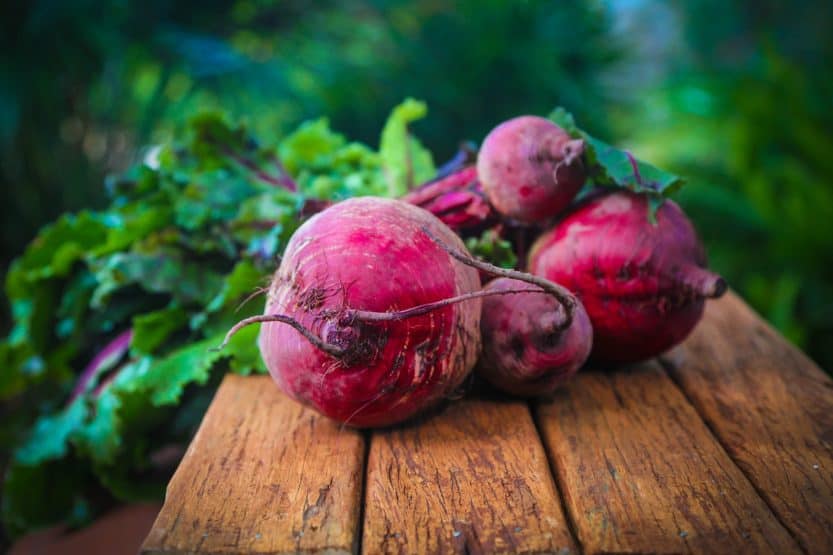
Beets are not only tasty but also packed with nutrients and can thrive in California’s mild May climate. They prefer loamy, well-draining soil with a good mix of organic matter. To plant, sow seeds directly into the garden at a depth of about ½ inch, spacing them 2-4 inches apart, as beet seeds often contain multiple seeds within one cluster. Keeping the soil evenly moist is key during germination, so water regularly but avoid over-saturation. Thinning the beet seedlings will promote healthy growth for the remaining plants. Harvest beets when they reach about 2-3 inches in diameter, and enjoy them roasted, in salads, or pickled for a delightful addition to any meal.
Soil Preparation: Beets thrive in well-drained soil with good organic content, ensuring deeper root development.
Planting Technique: Sow seeds in rows, covering them lightly with soil.
Watering Needs: Maintain consistent moisture, particularly in the lead-up to harvest.
Thinning Suggestions: After germination, thin seedlings to prevent overcrowding and allow proper growth.
Harvesting Timing: Beetroots can be harvested when they reach 2-3 inches in diameter for optimal flavor.
Storage Options: Store harvested beets in a cool, dry place; they can last several weeks under proper conditions.
Kale
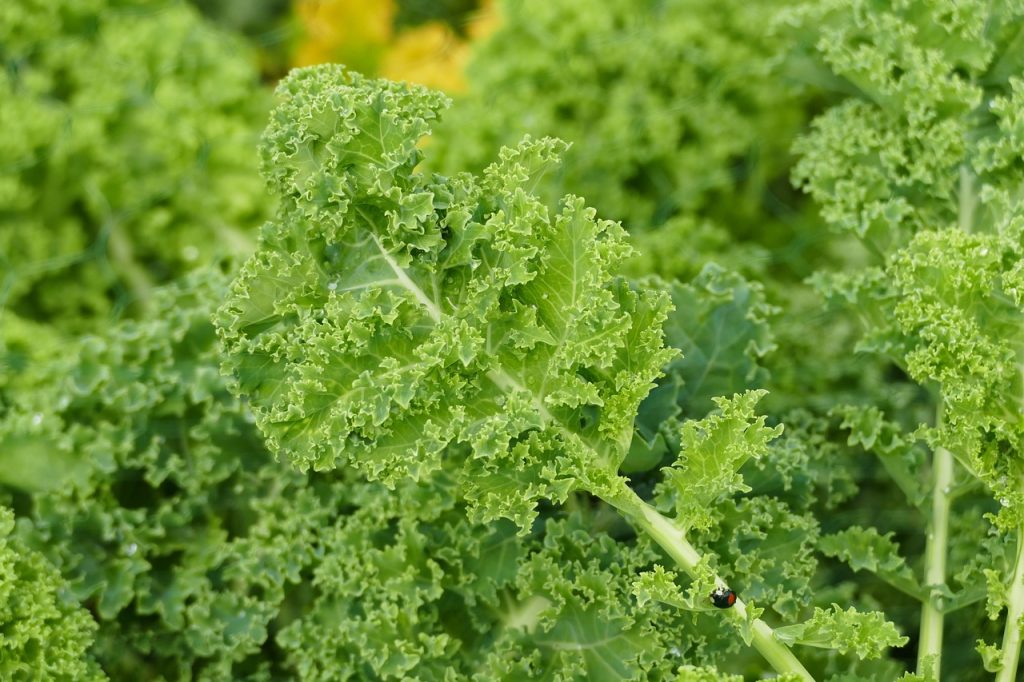
Kale is a power-packed leafy green that appreciates the cooler temperatures of the early summer months in California. May presents a great opportunity to plant kale seeds directly into well-tilled soil rich in organic matter. Choose a sunny spot with partial shade, as kale can tolerate a bit of temperature fluctuation. Sow seeds about ¼ to ½ inch deep and thin them to about 12-18 inches apart once seedlings have established. Regular watering is crucial as kale enjoys slightly moist soil, and a steady moisture supply helps push growth. Regularly harvesting the outer leaves encourages the plant to produce more foliage, ensuring you have a continuous supply of fresh greens throughout the summer.
Soil Requirements: Kale thrives in rich, well-structured soils with good drainage.
Sowing Depth: Seeds should be buried about ¼ – ½ inch deep.
Spacing: Once seedlings are established, space them 12-18 inches apart.
Watering: Ensure a steady supply of moisture during growth phases but avoid waterlogging.
Culinary Uses: Kale is versatile; it can be consumed raw in salads or cooked in a variety of dishes.
Fertilization: A well-balanced fertilizer can be beneficial throughout the growing season.
Flowers To Plant
May is a beautiful month in California gardens, and planting flowers can add vibrant colors and enhance your landscape. Here’s a closer look at essential flowering candidates suited for the May climate:
Sunflowers
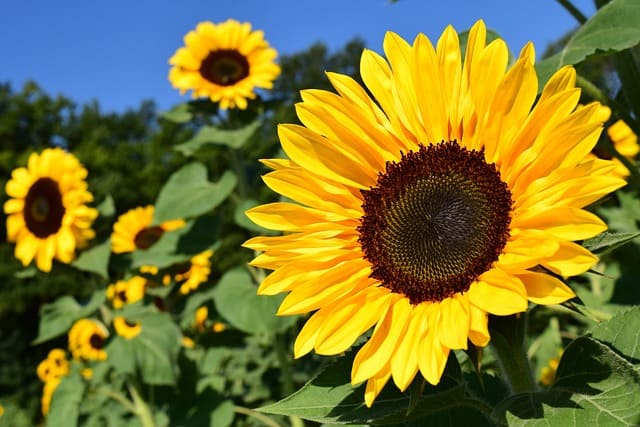
Sunflowers are one of the most recognizable and cheerful flowers that can elevate any California garden. With their large, radiant blooms, these plants thrive in the warmth of May, making it an excellent time to sow seeds directly into well-drained soil. Choose a sunny location, as sunflowers require at least 6-8 hours of direct sunlight daily to grow tall and strong. Plant seeds about 1-2 inches deep, spacing them adequately depending on whether you choose tall or dwarf varieties. Once established, watering should be done deep and infrequently, allowing the soil to dry slightly between waterings. Sunflowers not only beautify your garden but also attract beneficial pollinators.
Soil Conditions: Sunflowers prefer well-drained, fertile soil that has good organic content.
Spacing: Space seeds according to their mature size, usually about 6-12 inches apart.
Watering Needs: Water deeply once a week; avoid overhead watering.
Sunlight Requirements: Sunflowers thrive best in full sun, ideally with at least 6-8 hours of sunlight daily.
Safety Tips: Keep an eye out for pests; birds and squirrels may snack on seeds.
Harvesting Flowers: Sunflower heads can be harvested once the florets have begun to dry and the seeds display their mature color.
Marigolds
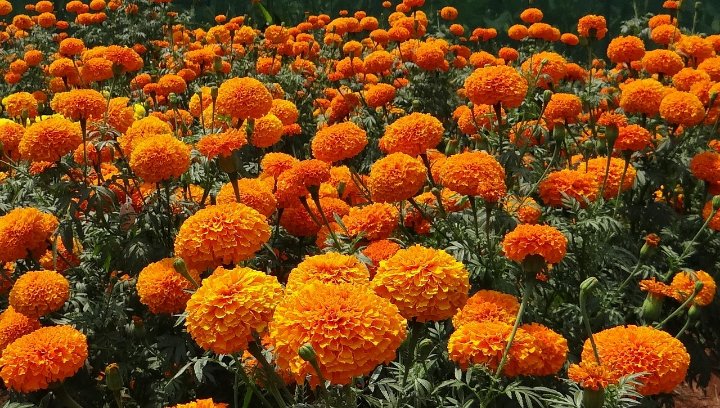
Marigolds are a classic choice for adding vibrant colors to your garden while also acting as a natural pest deterrent. May is perfect for sowing marigold seeds directly into well-drained, fertile soil, where they can thrive in full sun. Choose a location that receives at least six hours of sunlight each day; marigolds are adaptable but flourish best under sunny conditions. Space plants about 6-12 inches apart to allow for adequate air circulation and growth. Water marigolds regularly, particularly during dry spells, but be cautious of overwatering. A light layer of mulch can help retain moisture and suppress weeds. Deadheading spent blooms encourages further flowering throughout the season.
Soil Requirements: Marigolds thrive in rich, well-draining soil to maintain healthy growth.
Spacing Options: Space plants 6-12 inches apart depending on variety size.
Watering Guidelines: Regular watering is essential, especially during prolonged dry conditions.
Sunlight Exposure: Marigolds prefer full sun and generally require at least 6 hours of direct sunlight.
Pests Prevention: Marigolds can deter common garden pests, including nematodes, when planted strategically.
Design Ideas: Consider planting in borders or containers to maximize visual impact.
Zinnias
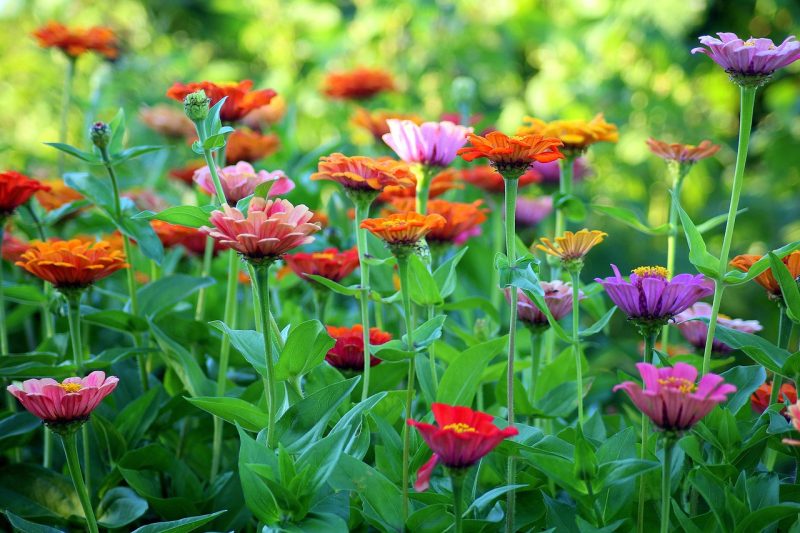
Zinnias are incredibly versatile and vibrant flowers that bloom profusely with minimal care. Planting zinnia seeds in May allows them to thrive under the full summer sun, as these flowers require at least six hours of sunlight each day for optimal growth. Choose well-drained soil enriched with organic material for the best results, and you can either sow seeds directly in the garden about ¼ inch deep or transplant seedlings started indoors. Space plants 10-12 inches apart to provide room for growth and good air circulation. Regular watering is essential to keep the soil consistently moist, especially during germination. Removing faded flowers will encourage continued blooming throughout the growing season.
Soil Preparation: Zinnias prefer sandy, well-drained soil, so amend accordingly if needed.
Planting Technique: Sow seeds directly about ¼ inch deep or transplant seedlings when temperatures warm.
Spacing Recommendations: Space plants at least 10-12 inches apart to allow for bushy growth.
Watering Needs: Maintain consistent moisture during flowering; avoid letting the soil dry out completely.
Pests & Diseases: Watch for aphids and mildew; address promptly with organic pesticides if needed.
Creative Ideas: Mix various colorful varieties to create stunning visual displays.
Cosmos
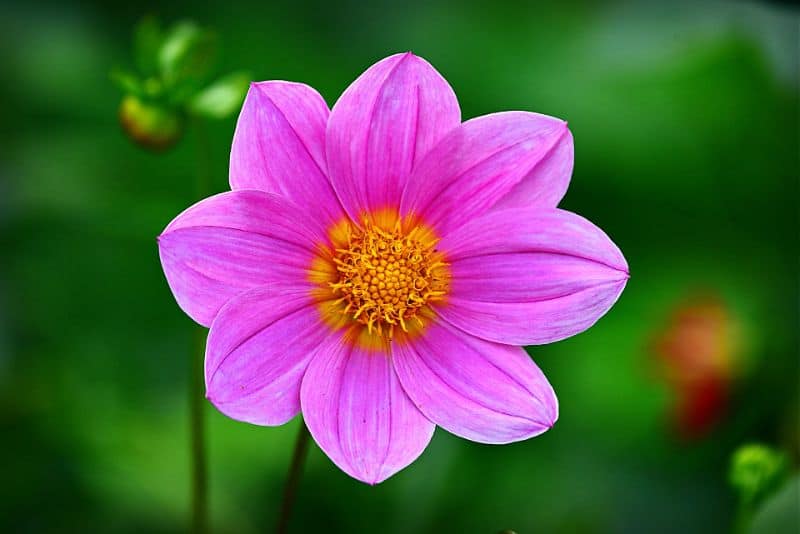
Cosmos are stunning annual flowers that can bring a delightful array of colors to your garden. May is an ideal month for planting cosmos seeds directly into the garden, as they flourish in full sun. Plant seeds about ¼ inch deep, spacing them at least 12-18 inches apart to allow for their bushy growth habit and sufficient air circulation. Cosmos thrive in relatively poor soils, so avoid over-fertilizing, which can lead to leggy plants. Regular watering is vital during establishment, but once rooted, cosmos can tolerate periods of drought. These flowers excel in attracting butterflies and beneficial insects, making them an excellent choice for enhancing your garden’s ecology.
Soil Conditions: Cosmos prefer well-drained, slightly sandy or poor soils.
Planting Technique: Seeds can be sown directly in the garden or started indoors beforehand.
Spacing: Space plants about 12-18 inches apart to encourage proper airflow.
Watering Needs: Ensure soil is moderately moist, particularly during early growth stages.
Pest Awareness: Generally pest-resistant, but keep an eye out for aphids and spider mites.
Harvesting Tips: Regularly cut flowers to promote new growth and flowering.
Gladiolus

Gladiolus are elegant perennial flowers that add a dramatic flair to gardens with their tall spikes of blooms. May is a great time to plant gladiolus corms in California since the soil is warm enough to encourage growth. Choose well-drained, fertile soil and plant corms about 4-6 inches deep, with spacing of around 6-12 inches apart to accommodate their height and promote airflow. Gladiolus plants thrive in full sunlight, so select a location that receives at least six hours of direct sun each day. Water the plants regularly, especially during dry spells, as they require consistent moisture for optimal blooming. After flowering, cut the spikes back to encourage continued growth.
Soil Needs: Gladiolus prefer well-drained, nutrient-rich soil enriched with organic matter.
Spacing Recommendations: Space the corms about 6-12 inches apart to allow for growth.
Water Requirements: Water frequently to maintain consistent moisture, especially during the blooming period.
Sunlight Needs: Full sun location is ideal; they thrive on direct sunlight for a major portion of the day.
Pest Management: Monitor for pests like aphids and thrips and take necessary measures to control them.
Post-Bloom Care: After flowering, cut back the spent blooms to maintain the plant’s vigor and encourage future growth.
Petunias

Petunias are one of the most popular bedding plants, offering vibrant colors and delightful scents, making them excellent for gardens and containers. In May, plant petunia seedlings outdoors in well-drained, fertile soil that has been enriched with organic matter. They thrive in full sun, requiring at least six hours of sunlight for robust blooming. Space plants about 10-12 inches apart to facilitate airflow. Petunias benefit from regular watering, particularly during hot weather, but take care not to oversaturate the soil. Deadheading spent flowers fosters continued blooms throughout the growing season, ensuring that your garden remains beautiful all season long.
Soil Requirements: Petunias prefer well-drained, fertile soil to support vibrant growth.
Planting Technique: Transplant seedlings or sow seeds directly outdoors once temperatures warm.
Spacing: Space plants about 10-12 inches apart for optimal air circulation.
Watering Guidelines: Water lightly but consistently during flowering, avoiding water on leaves to reduce disease risk.
Maintenance Strategies: Regular deadheading encourages new blooms and maintains plant vigor.
Container Growing: Petunias thrive in pots and hanging baskets, providing stunning displays in varied settings.
Cleome

Cleome is a unique and striking flower, commonly known as spider flower, that adds an architectural touch to gardens. May is the perfect time to plant cleome seeds directly in well-drained soil, as they thrive in full sun. Space seeds about 12-18 inches apart to accommodate their full growth potential and provide plenty of air circulation. Cleome is tolerant of poor soils, making it an excellent choice for more challenging garden spaces. Water regularly during the establishment phase but reduce frequency as they mature and become more drought-tolerant. These plants are known to attract pollinators, specifically hummingbirds and butterflies, adding life and movement to your garden.
Soil Preparation: Cleome prefers well-draining, sandy soils that allow for root expansion.
Spacing Guidelines: Space plants adequately to avoid overcrowding and ensure airflow.
Watering Needs: Keep the soil moist during establishment; reduce frequency as plants mature.
Planting Depth: Seeds should be sown about ¼ inch deep.
Sunlight Requirements: Full sun exposure is ideal for optimum growth and blooming.
Pest Resistance: Typically pest-resistant, but watch for spider mites and aphids.
Sweet Alyssum
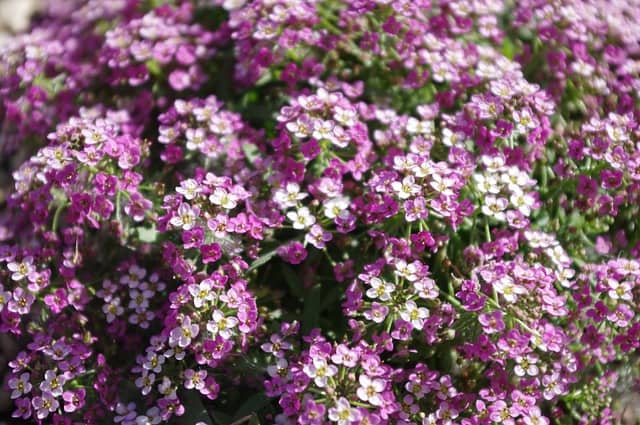
Sweet Alyssum is a charming, fragrant flower that works wonderfully as a ground cover or in containers. May is an excellent time to sow seeds directly in well-drained soil. This plant flourishes in cooler temperatures, producing delicate white, pink, or purple flowers. Ideal for sunny or slightly shaded spots, sweet alyssum prefers a location with at least 4-6 hours of sunlight each day. Plant seeds about ¼ inch deep and thin seedlings to about 12 inches apart once plants are established. Regular watering will keep the soil moist; however, they are relatively drought-tolerant once matured. This flower also attracts beneficial insects, further enhancing your garden’s ecosystem.
Soil Requirements: Sweet alyssum prefers well-drained soil that is slightly sandy or loamy.
Planting Technique: Sow seeds directly in the garden bed, lightly covering them.
Spacing Recommendations: Thin seedlings to around 12 inches apart to promote airflow and healthy growth.
Watering Needs: Maintain moisture consistently; avoid drying out completely.
Pest Identification: Generally pest-resistant; however, keep an eye out for aphids.
Companion Planting: Works well as a companion plant and attracts beneficial pollinators.
Dahlias
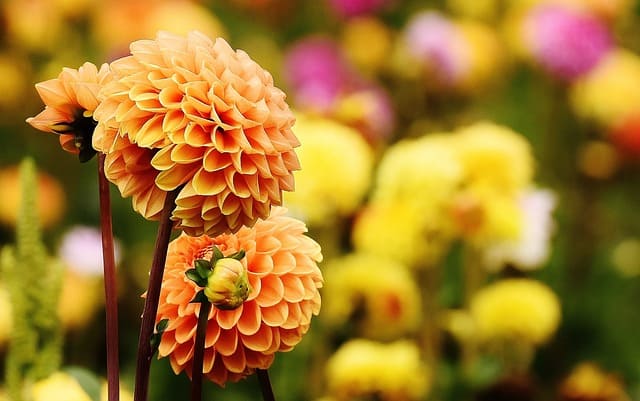
Dahlias are known for their stunning, expansive blooms and richness in color, which can elevate any garden space. May is the ideal time to plant dahlia tubers in well-draining, fertile soil. Look for a full-sun location with ample room for their expansive growth. Plant tubers about 6-8 inches deep with the “eyes” facing up, spacing them 2-3 feet apart. Water thoroughly after planting and keep the soil consistently moist during early growth; however, be mindful of overwatering that can lead to rot. Regular deadheading keeps blooms coming all summer long, ensuring vibrant displays throughout the season.
Soil Needs: Dahlias thrive in well-draining, nutrient-rich soil that has been amended with compost.
Spacing Requirements: Space tubers 2-3 feet apart depending on the variety size.
Watering Needs: Water consistently while avoiding waterlogging the soil.
Sunlight Exposure: Dahlias need full sun for robust growth and flowering.
Fertilization Guidelines: Start a periodic feeding with a balanced fertilizer to boost growth.
Pest Management: Monitor for pests like aphids and slugs, and act promptly if detected.
Perennial Flowers To Plant
Perennials are a fantastic addition to any garden, providing lasting beauty year after year. Planting them in May allows for a robust start to thriving blooms and green foliage.
Lavender
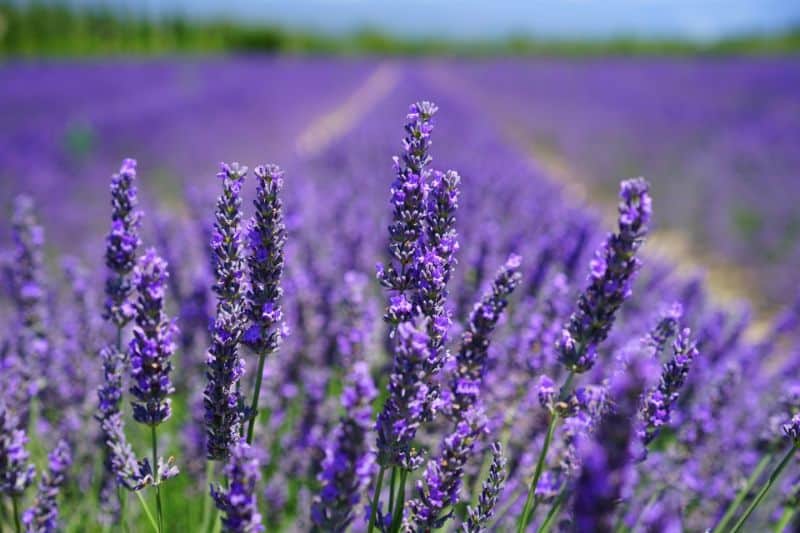
Lavender is a fragrant and attractive herb perennial, perfectly suited for California’s dry climate. Planting in May allows for ample growth before summer heat sets in. Choose well-drained, sandy soil rich in organic material for optimal aroma and color. This plant flourishes in full sun, requiring at least 6-8 hours of direct exposure daily. Space seedlings 12-18 inches apart to allow for their bushy growth. Water moderately during establishment; once established, lavender demonstrates remarkable drought tolerance. Regular pruning after blooming will promote a bushier growth habit, ensuring your lavender plants remain thriving and visually appealing.
Soil Type: Lavender thrives in loamy, well-drained soil with good drainage.
Planting Recommendations: Plant in a location that receives full sun, ensuring ample light exposure.
Spacing: Give plants about 12-18 inches of space to ensure proper air circulation.
Watering Needs: Once established, lavender is drought-tolerant, requiring little water.
Pruning Practices: Prune each year after flowering to maintain shape and vigor.
Culinary Uses: Harvest flowers for culinary delights; they can enhance desserts and teas.
California Poppy
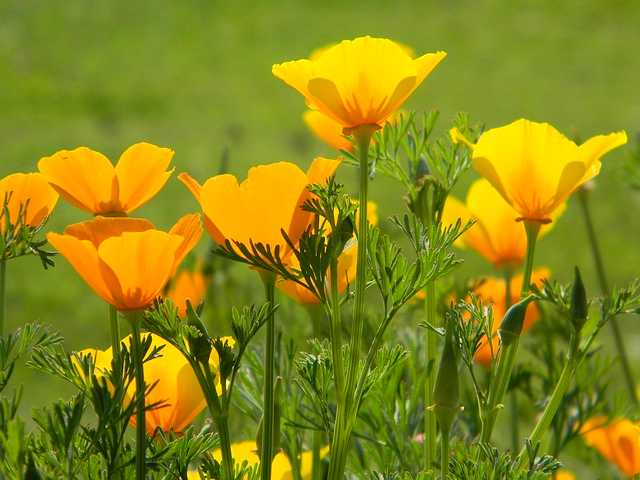
As California’s state flower, the California poppy is known for its vibrant orange hue and compatibility with Mediterranean climates. May is an ideal month for sowing seeds directly into dry, well-drained soils. Since they naturally thrive in poor soils, avoid over-fertilizing. Scatter seeds on the surface, pressing gently and covering lightly; they need light to germinate. California poppies prefer full sunlight, ideally growing in areas that receive 6-8 hours of sun each day. Once established, they are highly drought-tolerant. Allow the plants to self-seed to enjoy their stunning blooms year after year without replanting.
Soil Conditions: Poppies thrive in sandy or rocky, well-drained soils.
Planting Method: Scatter seeds lightly on the soil surface and firm it down, as light aids germination.
Sunlight Exposure: Full sun is ideal; poppies require adequate sunlight to flourish.
Watering Needs: Allow poppies to dry out between waterings once established; they prefer drier conditions.
Naturalization: California poppies can self-seed, providing seasons of color with minimal upkeep.
Harvesting Tips: Cutting back spent flowers can encourage more blooms throughout the summer.
Coneflower
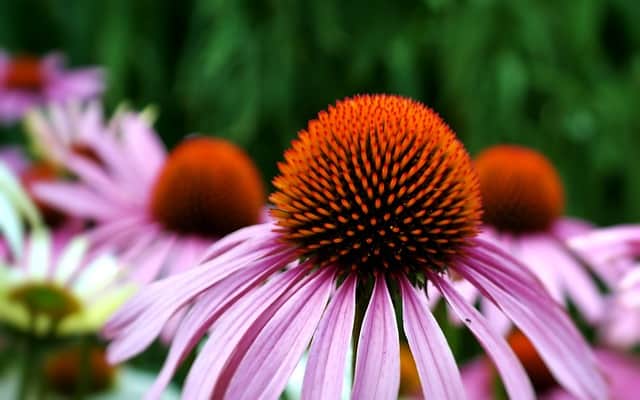
Coneflower, or Echinacea, is a durable perennial renowned for its beauty and health benefits. May is an excellent month for planting coneflower seeds or transplants in well-drained soil in sunny areas. Space plants about 12-18 inches apart to ensure proper air circulation and access to sunlight. These flowers thrive in full sun but will tolerate some shade. Regular watering is required during establishment, but once mature, coneflowers exhibit drought resistance. Removing spent blooms through deadheading encourages a longer flowering period, making them a valuable addition for both aesthetic appeal and pollinator attraction in your garden.
Soil Needs: Coneflowers prefer well-drained, somewhat poor soils; they do not require highly fertile ground.
Sunlight Conditions: Full sun is ideal for coneflowers to thrive and reach their full potential.
Spacing Recommendations: Ensure a spacing of 12-18 inches for each plant.
Watering: Water regularly during establishment but reduce to infrequent watering once established.
Pest Awareness: Generally resistant to pests, although watch for issues related to aphids.
Harvesting Flowers: Gather blooms for dried arrangements or fresh bouquets.
Daylily
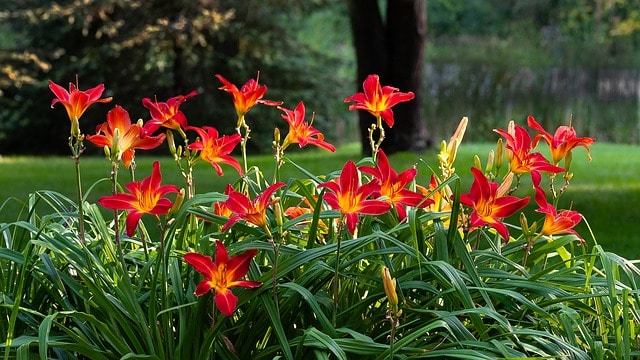
Daylilies are hardy perennials that add vibrant swaths of color without excessive care. May is optimal for planting daylily rhizomes in well-drained, rich soil for robust growth. Choose a sunny or slightly shaded area, as daylilies can adapt to various light levels but prefer full sun. Space the plants about 12-18 inches apart to allow for their sprawling growth and promote airflow. Water regularly to maintain even soil moisture, especially during dry spells. Daylilies are resilient and can withstand less-than-ideal conditions; trimming back spent blooms encourages a healthier, more robust plant for the following season.
Soil Requirements: Daylilies thrive in rich, well-drained soils with adequate nutrients.
Spacing Options: Space daylilies about 12-18 inches apart for optimal growth.
Watering Needs: Keep soil moderately moist during early establishment; they naturally tolerate drought once mature.
Light Preferences: They prefer full sun, but daylilies can adapt to partial shade.
Pruning Suggestions: Deadheading encourages follow-up blooms and maintains the plant’s vigor.
Harvesting Flowers: Utilize daylily flowers in salads for culinary enjoyment or culinary use.
Black-eyed Susan
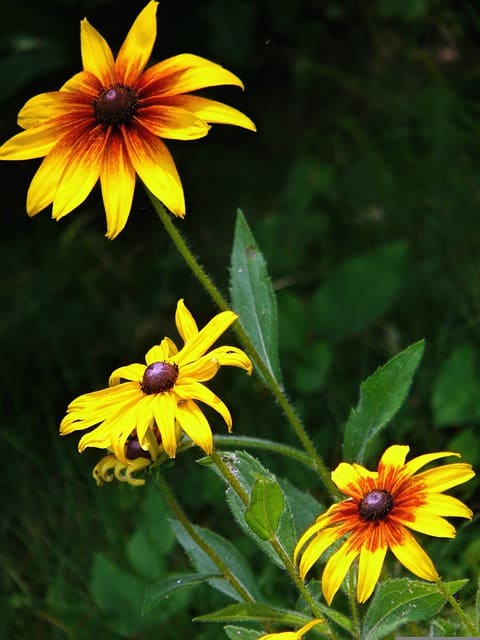
Black-eyed Susans bring bright color and resilience to any garden. May is a great time to plant these perennials in well-drained soil that receives at least 6-8 hours of direct sunlight. Select a location that allows for full sun exposure, as this encourages vigorous growth and flowering. Space mature plants approximately 12-24 inches apart to ensure good airflow and prevent overcrowding. Water regularly during establishment and reduce frequency as plants mature; they are relatively drought-tolerant once established. These flowers often self-seed, allowing for future blooms without needing to replant.
Soil Conditions: Black-eyed Susans prefer well-drained, fertile soils.
Spacing Recommendations: Space plants 12-24 inches apart to allow full growth potential.
Sunlight Requirements: They thrive in full sun, ideally receiving at least 6 hours of light daily.
Watering Needs: Keep the soil moderately moist during establishment and allow it to dry out between waterings as they mature.
Pest Resistance: Generally disease and pest resistant, making them a low-maintenance choice.
Harvesting Tips: Cut back spent blooms to promote re-blooming and extend summer color.
Agastache
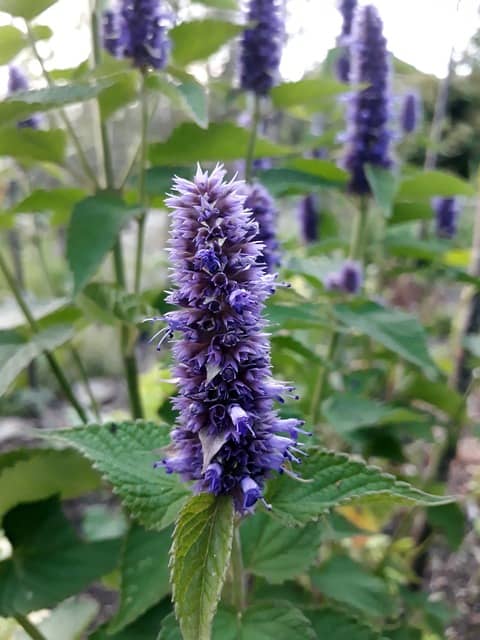
Agastache, or hummingbird mint, adds vibrant colors and fragrant foliage to gardens, drawing in pollinators. Planting in May allows for strong establishment before hotter months set in. Choose a sunny spot with well-draining soil for optimal growth. Space plants 12-18 inches apart to allow for their bushy growth. Agastache is drought-tolerant once established; regular watering is essential during the initial weeks. Deadheading spent flowers will encourage continued blooming through the growing season. Their aromatic leaves can also be used in culinary applications, making them a delightful dual-purpose plant.
Soil Needs: Agastache prefers well-drained, sandy soils that don’t retain moisture excessively.
Planting Technique: Space plants adequately for air circulation, giving them room to spread.
Sunlight Conditions: Full sun exposure supports the best flowering and growth.
Watering Needs: Regular watering for the first few weeks is essential; once established, they require less.
Pest Management: Generally pest-resistant but should be monitored for aphids and other minor pests.
Culinary Uses: Use leaves fresh or dried in teas and culinary preparations; they provide a minty flavor.
Salvia
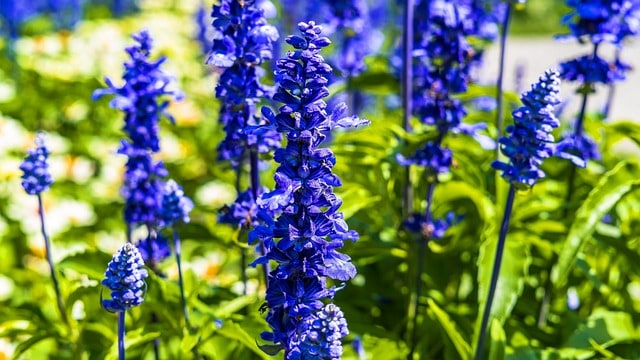
Salvia comes in many varieties and can add both beauty and fragrance to your garden. May is the ideal time to plant salvia, as they thrive on the warm temperatures of California. Select well-draining soil with moderate fertility and a location that receives full sun for at least 6 hours. Space plants 12-24 inches apart for adequate growth and airflow. Regular watering is necessary during the establishment period; once established, salvia is remarkably drought-tolerant. Pruning spent flowers encourages additional blooms. Salvia provides a wonderful habitat for hummingbirds and other beneficial wildlife.
Soil Conditions: Salvia prefers sandy or loamy soils with good drainage capabilities.
Sunlight Needs: Thrives best in full sun, requiring adequate light for robust growth.
Spacing Recommendations: Space plants 12-24 inches apart to allow for their mature size.
Watering Needs: Keep soil moist during establishment; gradually reduce as the plant grows.
Pest Awareness: Typically pest-resistant, though regular monitoring is a good practice to keep them healthy.
Design Ideas: Use salvia varieties in mixed borders for visual interest and pollinator attraction.
Astilbe

Astilbe is a stunning perennial known for its feathery, plumed flowers that add elegance to shady spots. May is an excellent time to plant astilbe in well-drained, rich soils that retain moisture. Choose a shaded or partially shaded area, as astilbe does not perform well in full sun. Space plants about 12-18 inches apart for proper airflow. Keep the soil evenly moist, as these plants prefer consistent moisture for optimal blooming. Mulch around the plants will help retain soil moisture. After flowering, allow foliage to die back naturally to promote healthy growth for the following season.
Soil Requirements: Astilbe thrives in well-drained soils that are rich in organic matter.
Sunlight Exposure: Prefers partial shade to full shade for best performance.
Spacing Options: Space plants about 12-18 inches apart.
Watering Needs: Ensure that the soil remains evenly moist, particularly in hotter months.
Maintenance Tips: Mulch around plants to retain moisture and keep weeds down.
Color Variety: Bloom colors range from white to pink to red, providing options for every garden scheme.
Penstemon
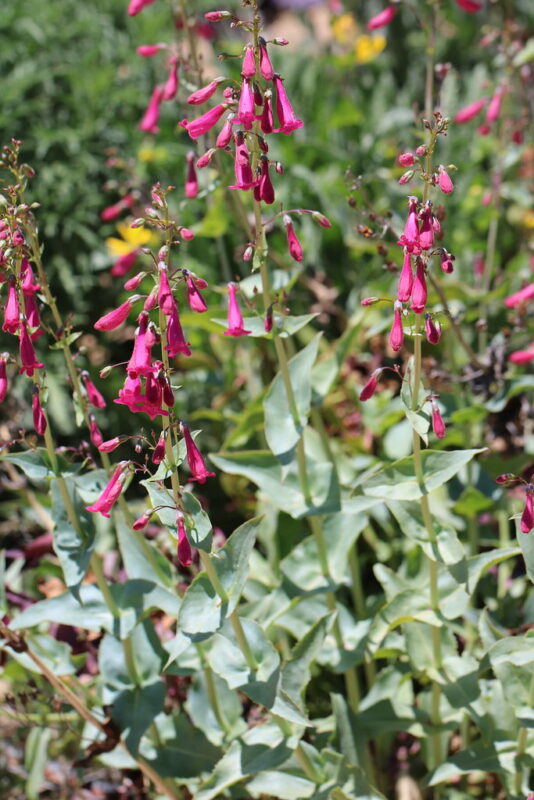
Penstemon, known for its tubular flowers and resilience, lends color to gardens while attracting pollinators. May is the ideal time to plant penstemon seeds or transplants in well-draining, sandy soils. Space plants 12-18 inches apart to ensure adequate airflow and reduce disease risk. These plants thrive in full sun conditions; if planting in cooler areas, some light afternoon shade can promote better growth. Water regularly during establishment to help roots develop, and reduce watering frequency once they mature and become more drought-tolerant. Deadheading will encourage additional blooms, enhancing their display throughout summer.
Soil Conditions: Prefers well-drained, sandy soil for maximum growth potential.
Sunlight Needs: Penstemon thrives best when planted in full sun.
Spacing Options: Space plants approximately 12-18 inches apart for proper airflow.
Watering Needs: Regular watering during establishment is key; reduce frequency as they mature.
Pest Management: Generally resistant to pests; regular checks for aphids or spider mites are advised.
Culinary Uses: Some penstemon varieties may also have edible flowers, enhancing their utility.
Sedum
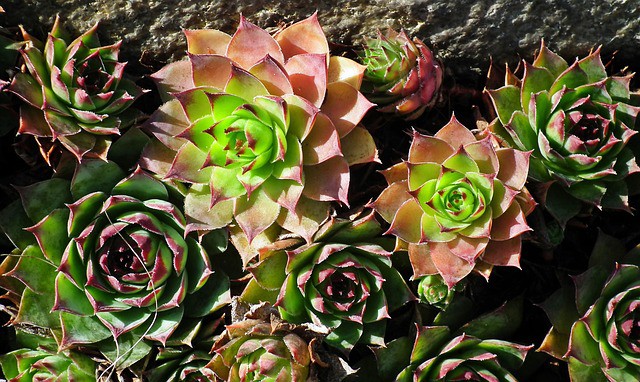
Sedum, or stonecrop, is a hardy succulent that thrives in dry conditions. May is the perfect time to plant sedum, as they enjoy warm temperatures and can establish before the heat of summer. Select well-draining spaces, such as rocky areas or raised beds, to ensure good drainage. Space plants about 12-24 inches apart, allowing for spreading growth. Water gently after planting and keep the soil slightly moist until established, before allowing to dry out between waterings. Minimal maintenance is required; simply remove any dead leaves or excess growth to maintain appearance.
Soil Preparation: Sedum prefers sandy, rocky soils with excellent drainage.
Spacing Recommendations: Space plants roughly 12-24 inches apart to allow expansion.
Watering Needs: Water sparingly until established; once rooted, they can withstand drought.
Light Preferences: Thrives in full sun conditions.
Color Variations: Blooms can range from yellow to pink to red, ideal for diverse garden aesthetics.
Pruning Practices: Trim back spent blooms and dead foliage to promote new growth.
Bulbs To Plant
May is also a great time to plant various bulbs that will produce vibrant summer blooms, adding life and color to your California garden.
Lilies

Lilies are elegant flowers that bring beauty and fragrance to gardens. May is a perfect month to plant lily bulbs in well-drained, nutrient-rich soil. Choose a sunny location with protection from fierce winds to prevent damage to the tall stalks. Plant bulbs about 6-8 inches deep, ensuring they are spaced adequately based on their mature size. Water thoroughly after planting to promote root growth and maintain consistent moisture, while avoiding soggy conditions. Monitoring for pests throughout the growing season is essential to protect your beautiful blooms. With proper care, lilies will reward you with stunning summer blooms.
Soil Conditions: Lilies prefer well-drained, nutrient-rich soil.
Spacing Recommendations: Space bulbs 6-12 inches apart to facilitate growth.
Watering Needs: Water consistently to avoid soggy soil; they prefer even moisture.
Sunlight Exposure: Planting in a sunny area with partial shade works best.
Pest Management: Monitor for pests like aphids and caterpillars, addressing infestations promptly.
Post-Bloom Care: Remove spent flowers to promote vigor and healthier blooms.
Gladiolus

Gladiolus add dramatic color and height to any garden, making them a favorite in May planting. Prepare your planting area by selecting well-drained, fertile soil and a sunny location that receives at least 6 hours of sunlight daily. Plant corms about 4-6 inches deep and space them enough to allow airflow—around 6-12 inches apart. Regular watering is crucial during their flowering phase, so ensure the soil remains consistently moist but not waterlogged. Deadheading blooms to promote new flowers and consider cutting them for arrangements—gladiolus make stunning additions to indoor displays.
Soil Needs: Gladiolus prefer well-drained, nutrient-rich soil enriched with organic matter.
Spacing Requirements: Space the corms about 6-12 inches apart to allow for growth.
Watering Needs: Water frequently to maintain consistent moisture, especially during the blooming period.
Sunlight Needs: Full sun location is ideal; they thrive on direct sunlight for a major portion of the day.
Pest Management: Monitor for pests like aphids and thrips and take necessary measures to control them.
Post-Bloom Care: After flowering, cut back the spent blooms to maintain the plant’s vigor and encourage future growth.
Dahlias

Dahlias are known for their stunning blooms and vibrant colors, which can elevate any landscape. May is an ideal time to plant dahlia tubers in well-draining, fertile soil. Look for a full-sun location with ample room for their expansive growth. Plant tubers about 6-8 inches deep with the “eyes” facing up, spacing them 2-3 feet apart. Water thoroughly after planting and keep the soil consistently moist during early growth; however, be mindful of overwatering that can lead to rot. Regular deadheading keeps blooms coming all summer long, ensuring vibrant displays throughout the season.
Soil Needs: Dahlias thrive in well-draining, nutrient-rich soil that has been amended with compost.
Spacing Requirements: Space tubers 2-3 feet apart depending on the variety size.
Watering Needs: Water consistently while avoiding waterlogging the soil.
Sunlight Exposure: Dahlias need full sun for robust growth and flowering.
Fertilization Guidelines: Start a periodic feeding with a balanced fertilizer to boost growth.
Pest Management: Monitor for pests like aphids and slugs, and act promptly if detected.
Canna Lilies
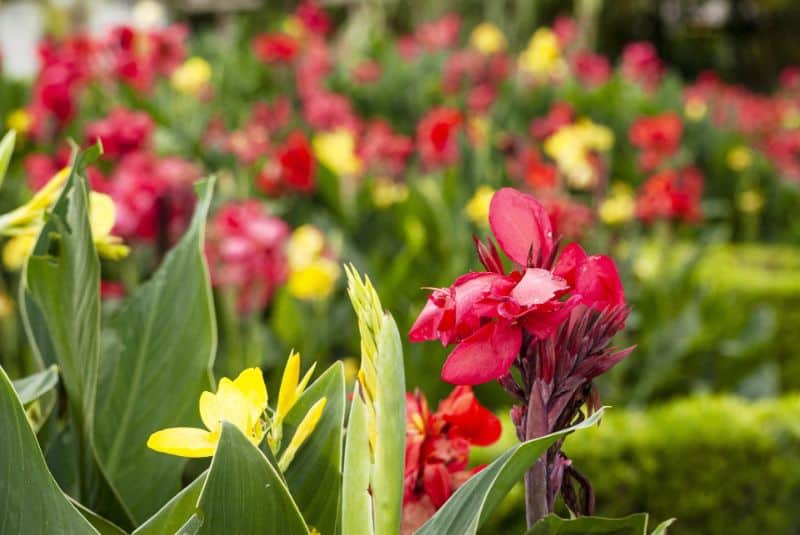
Canna lilies are tropical plants that produce striking blooms and dramatic foliage. May is a great time to plant canna tubers in rich, well-drained soils. Choose a sunny spot that will provide warmth and sufficient light throughout the growing season. Plant tubers about 4-6 inches deep, spacing them 2-3 feet apart to accommodate their large size and promote airflow. Water regularly, especially during dry spells, but avoid leaving waterlogged conditions. Deadhead spent flowers to encourage ongoing blooming throughout the growing season.
Soil Requirements: Canna lilies prefer well-drained, fertile soil for vigorous growth.
Spacing Guidelines: Space tubers 2-3 feet apart to allow for ample growth.
Watering Needs: Maintain consistent soil moisture, particularly during dry spells.
Sunlight Exposure: Planting in full sun will promote healthy growth and blooming.
Pest Management: Keep an eye out for pests, including aphids and caterpillars.
Post-Bloom Care: Trim spent flowers regularly to encourage further blooming and bushier plants.
Foxtail Lily
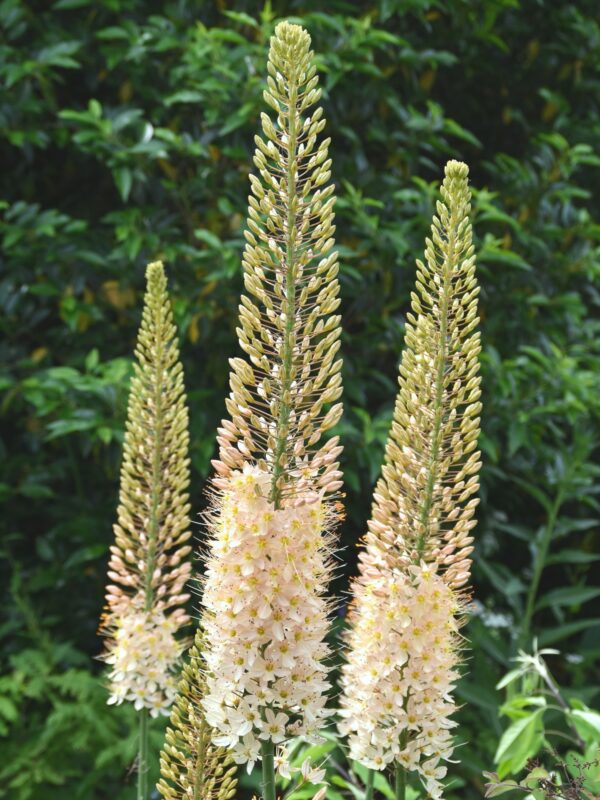
Foxtail lilies are known for their tall, elegant structure and unique flower spikes, adding a vertical element to gardens. May is an excellent time to plant these bulbs in well-drained soil that has plenty of organic matter. Choose a sunny location, as they require full sunlight for optimal growth. Plant bulbs about 4-6 inches deep, spacing them adequately to allow for growth. Water thoroughly to establish roots, and keep the soil moderately moist during the early growth phase. Monitor for pests and prune to shape as needed.
Soil Conditions: Foxtail lilies thrive in loamy soils that drain well and are rich in organic matter.
Spacing Recommendations: Space bulbs about 6-12 inches apart to allow for growth.
Watering Needs: Maintain moderate moisture levels without excessive waterlogging.
Sunlight Requirements: Provide full sun exposure for optimal growth.
Pest Awareness: Watch for aphids and other infestations and address them as necessary.
Harvesting Tips: Cut flowers for arrangements; they will add beauty both indoors and out.
Calla Lily
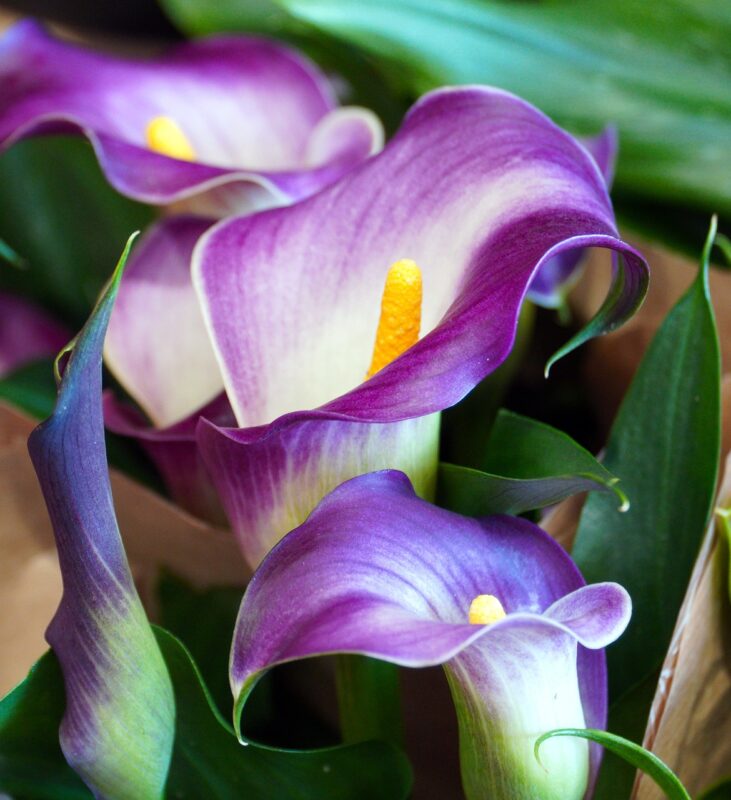
Calla lilies are elegant favorites, ideal for borders or containers. May is a suitable month for planting calla lily tubers in well-drained, fertile soil. Opt for a location that receives partial to full sunlight; these plants thrive in warm climates. Plant tubers about 4-6 inches deep, ensuring good spacing to allow for their mature growth and airflow. Water regularly during their initial growth stages to promote healthy root development, and allow the soil to dry out slightly between waterings as they mature. After blooming, let foliage wither naturally to support next year’s growth.
Soil Preparation: Calla lilies prefer rich, fertile soils that retain moisture but are well-drained.
Spacing Options: Space tubers around 12-18 inches apart for adequate room.
Watering Needs: Water regularly, ensuring the soil remains moist without being overly soggy.
Sunlight Requirements: Calla lilies thrive best in areas with partial to full sun.
Pest Monitoring: Keep an eye out for problems related to aphids and fungus.
Post-Bloom Care: Let foliage die back naturally to nourish the tuber for future growth.
Ranunculus
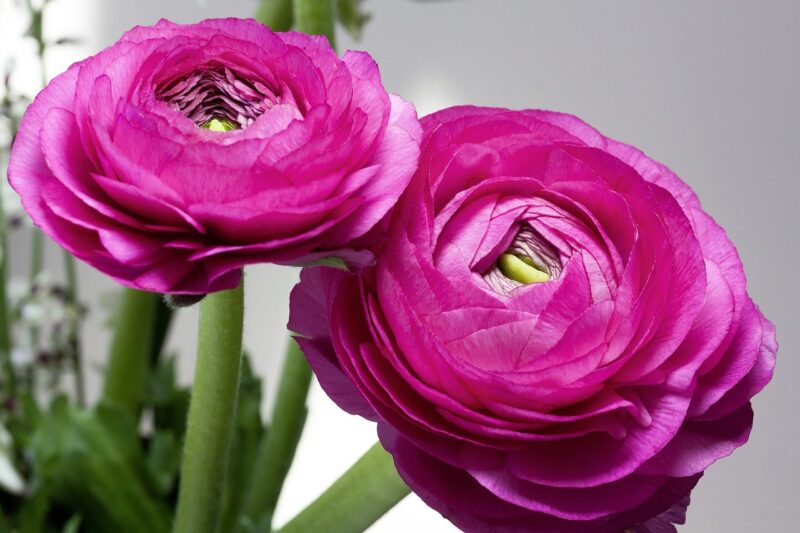
Ranunculus, or Persian buttercups, produce stunning, layered blooms that brighten any garden. May is a suitable time to plant their tubers in well-draining, fertile soil enriched with organic amendments. Choose a sunny location for planting, ensuring they receive plenty of sunlight. Plant tubers about 1-2 inches deep and space them 6-8 inches apart for optimal growth. Keep the soil moist during germination while allowing slight drying between waterings once they establish. These flowers make vibrant additions to outdoor spaces and stunning cut arrangements for indoors.
Soil Conditions: Prefer well-drained, moderately rich soils to thrive.
Spacing Requirements: Space tubers around 6-8 inches apart to support their growth.
Watering Needs: Maintain consistent moisture levels, particularly during germination.
Sunlight Exposure: These flowers require full sun for robust growth.
Post-Bloom Tips: Deadhead to encourage continued blooming throughout the season.
Cut Flower Uses: Enjoy cut ranunculus blooms indoors, as they make beautiful arrangements.
Alstroemeria
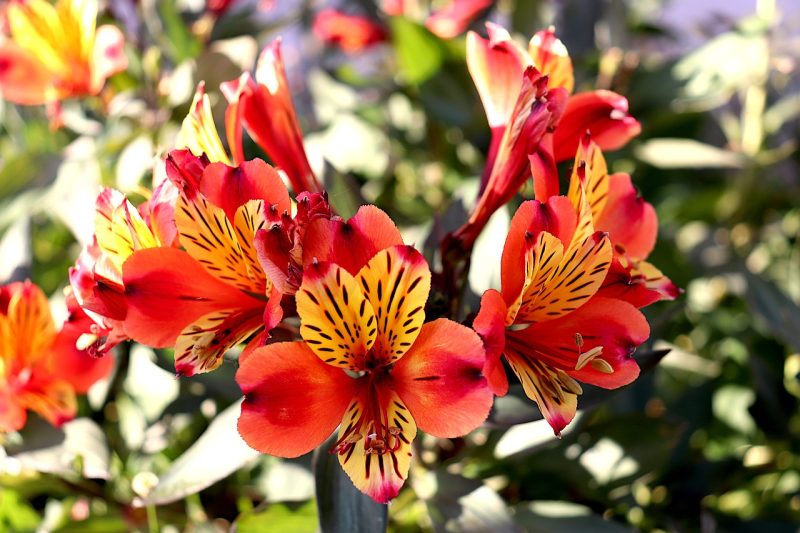
Alstroemeria, or Peruvian lily, is favored for its colorful and profuse blooms. May is an excellent time to plant alstroemeria in rich, well-draining soil. Select a sunny location that receives 6-8 hours of sunlight daily for optimal growth. Space plants about 12-18 inches apart to allow for expansion and airflow. Water thoroughly upon planting and maintain even soil moisture during establishment; once established, these tough plants will tolerate some drought. Regularly deadhead blooms to encourage more flowers, filling your garden with continuous color.
Soil Preparation: Alstroemeria prefers rich, well-drained soil to promote healthy growth.
Spacing Recommendations: Space plants 12-18 inches apart for optimal air circulation.
Sunlight Needs: Full sun is ideal for promoting flowering and growth.
Watering Needs: Keep soil evenly moist during establishment; reduce frequency as they mature.
Pest Management: Monitor for pests, including aphids, and treat as necessary.
Culinary Uses: In some traditions, edible varieties can also enhance meals.
Nerine
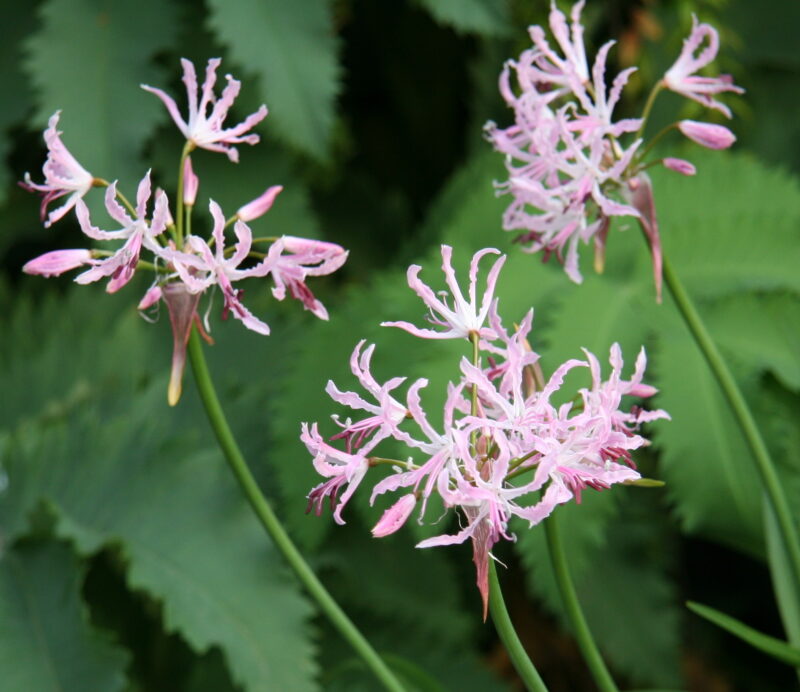
Nerine is a striking plant known for its bold, unique flowers. May is a great month to plant nerine bulbs in well-drained soil in a sunny area. Ensure the soil is rich in organic matter for best results. Plant bulbs about 4-5 inches deep and space them adequately to allow for growth. Water deeply, keeping the soil evenly moist during their establishment period; reduce watering once the plants show strong growth. Nerine will beautify your garden while requiring minimal care as they thrive in California’s climate.
Soil Conditions: Nerine flourishes in well-drained, sandy soils rich in organic matter.
Spacing Requirements: Space bulbs at least 6-12 inches apart.
Watering Needs: Water thoroughly after planting; reduce once established.
Sunlight Exposure: Full sun conditions encourage healthy blooms.
Post-Bloom Care: Allow foliage to die back naturally to nourish bulbs for next year’s growth.
Flower Arrangement Tips: Cut flowers display beautifully in arrangements, lasting well indoors.
Dutch Iris

Dutch iris offers lovely blooms and sophisticated colors, making them a popular choice for gardeners. May is ideal for planting Dutch iris bulbs, which thrive in sunny, well-drained areas with plenty of organic matter. Plant bulbs about 4 inches deep, spacing 6-8 inches apart to ensure good airflow. Water thoroughly after planting and keep the soil consistently moist during early growth, reducing water as they mature. Dutch iris blooms will provide stunning color and beauty to your home.
Soil Requirements: Dutch irises thrive in well-drained, fertile soils with organic amendments.
Spacing Recommendations: Space bulbs 6-8 inches apart to promote adequate growth.
Watering Needs: Keep soil moist initially, tapering off as plants mature.
Sunlight Needs: Full sun exposure helps to maximize growth and blooming potential.
Pest Awareness: Watch for pests; occasionally check for aphids.
Harvesting Tips: Harvest blooms for cut flowers to create beautiful arrangements.
Fruits To Plant
California’s mild climate allows a plethora of fruit options to be successfully grown. Here are essential planting tips for ten fruits suited to the May calendar:
Strawberries
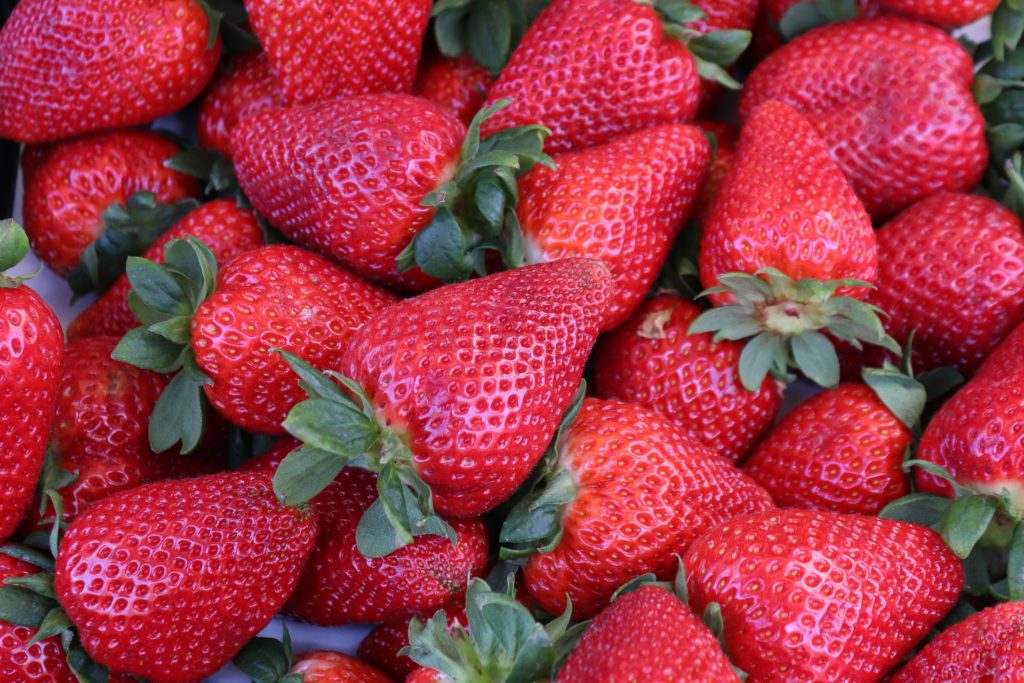
Strawberries are delightful additions that yield bountiful harvests, especially in home gardens. With May’s warm temperatures, it’s an ideal time to plant strawberries as they thrive in sunny conditions. Select a well-draining soil enriched with organic matter for optimal growth. Space plants about 12-18 inches apart in rows to allow room for spreading. Keep the soil consistently moist during establishment, and water deeply to ensure hydration during dry spells. Mulching around the plants will help retain moisture while also suppressing weeds. Regular harvesting encourages continued production throughout the summer.
Varieties: Consider June-bearing, everbearing, and day-neutral varieties depending on your growing conditions.
Soil Preparation: Strawberries thrive in fertile, well-drained soils with organic amendments.
Spacing Guidelines: Space plants 12-18 inches apart depending on variety and growing formulation.
Watering Needs: Regular watering during establishment is crucial; ensure soil remains moist but not soggy.
Pests and Diseases: Monitor for pests such as aphids, spider mites, and fungal diseases; early intervention is key.
Harvesting Timing: Harvest berries when fully colored and plump; they are sweetest just before over-ripening.
Blueberries
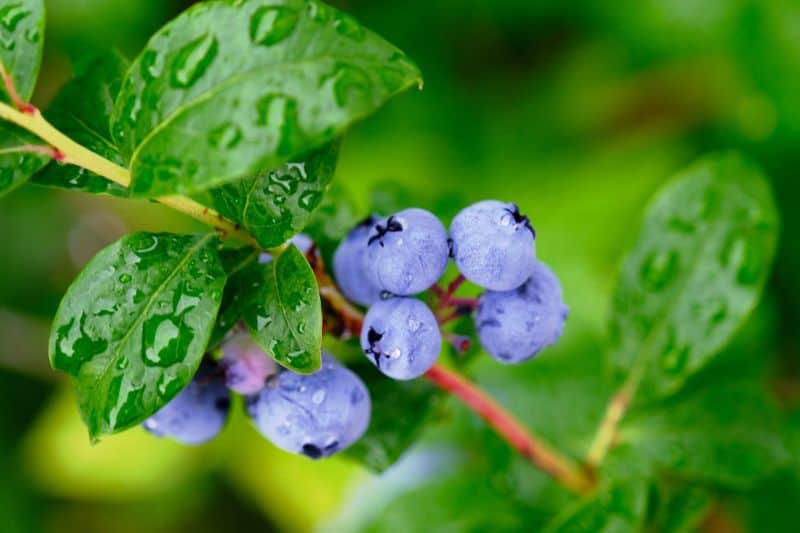
Blueberries are treasured for their sweet flavor and health benefits, but they require specific conditions to thrive. May presents a fantastic opportunity to plant healthy blueberry shrubs in well-drained, acidic soil with a pH between 4.5 and 5.5. Amend your planting area with peat moss or sulfur if needed to lower the pH. Choose a sunny spot in your garden that receives at least 6 hours of sunlight daily. Space plants 4-5 feet apart to ensure ample growth and airflow. Regular watering is essential, particularly during the early stages of development, to help establish deep roots; consider adding mulch to help retain moisture and discourage weeds.
Varieties: Select lowbush, highbush, or rabbiteye varieties based on your locale and preferences.
Soil Preparation: Blueberries prefer acidic soils, enriched with organic compost or peat moss.
Spacing Requirements: Space plants 4-5 feet apart to allow for mature foliage spread.
Watering Needs: Regular watering in the first year is crucial; established plants can tolerate slightly drier conditions.
Fertilization Tips: Use acid-based fertilizers to support healthy shrub growth.
Harvesting Timing: Enjoy berries as soon as they are fully ripe; they will typically darken for optimal sweetness.
Raspberries
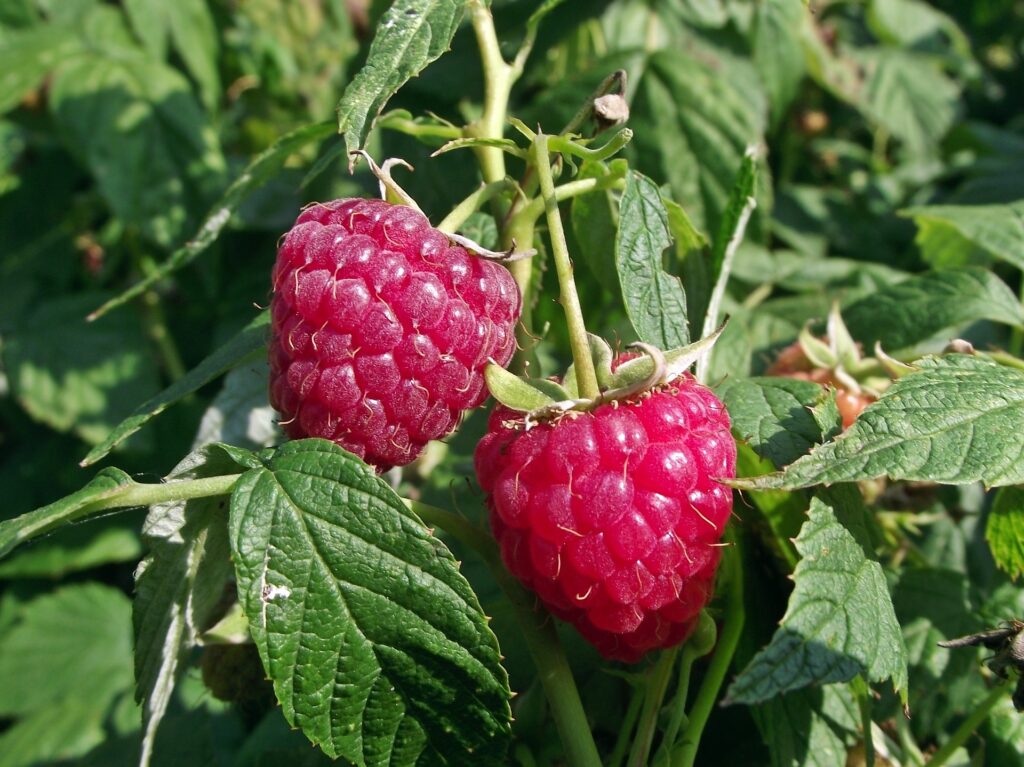
Raspberry plants can provide sweet harvests and are well-suited to many California climates. May is the perfect time to plant raspberry canes, as the soil warms up and frost risk decreases. Choose well-drained soil enriched with organic matter and a sunny location that receives at least 6-8 hours of sunlight per day. Space plants 2-3 feet apart, ensuring to provide trellises for support if you’re growing upright varieties. Regular watering during the first few weeks is essential for root establishment, but mature plants are quite drought tolerant. Prune canes annually after harvesting to promote healthier new growth and to maintain overall structure.
Varieties: Consider summer-fruiting and fall-fruiting varieties depending on desired harvest times.
Soil Preparation: Opt for well-drained, nutrient-rich soil, prepared with plenty of organic matter.
Spacing Guidelines: Space plants about 2-3 feet apart; trellis for upright growing types.
Watering Needs: Regular watering during establishment aids root development.
Fertilization Strategy: Feed with organic fertilizers to promote fruiting and growth.
Harvesting Season: Harvest berries when fully ripe, allowing them to deepen in color.
Blackberries
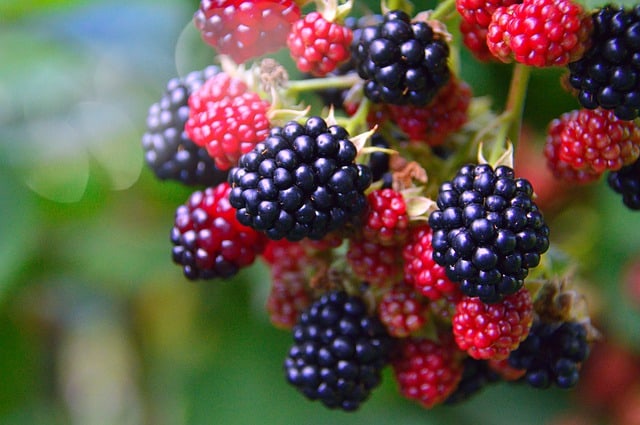
Blackberries are resilient fruits that can grow abundantly in California gardens. Planting in May allows these plants to establish roots before the heat of summer sets in. Choose a well-drained area with plenty of sunshine, as blackberries thrive in full sun. Plant canes 3-4 feet apart, ensuring adequate spacing for their vigorous growth and support structures if necessary. Regular watering during the first few weeks is essential for root establishment, but mature plants are quite drought tolerant. Prune canes annually after harvesting to promote healthier new growth and maintain overall structure.
Varieties: Choose thorny or thornless varieties based on your preference.
Soil Preparation: Blackberries thrive in well-drained, rich soil.
Spacing Recommendations: Space plants around 3-4 feet apart to accommodate their large size.
Watering Needs: Ensure adequate water during establishment; reduce as they fortify themselves.
Pest Management: Monitor plants for pests, including aphids and thrips, using organic methods to control them.
Harvesting Timing: Harvest when fruits turn completely black and plump for the best sweetness.
Tomatoes

Tomatoes are a popular choice among backyard gardeners in California and thrive best when planted in May. Start with healthy seedlings or seeds indoors and transplant them once the danger of frost has passed. Select a location with well-draining, fertile soil, enriched with compost, and ensure it receives full sun for at least 6-8 hours daily. Space tomato plants 18-24 inches apart to allow for airflow and growth. Water deeply at the base to encourage root development, and mulching can help retain moisture in the soil. As the plants grow, consider using stakes or cages for support, which helps with airflow and prevents disease.
Varieties: Select from numerous varieties that thrive in the California climate, including Early Girl, Brandywine, Roma, and San Marzano.
Soil Preparation: Tomatoes grow best in well-drained, fertile soil that has a balanced pH.
Transplanting Guidelines: Space plants 18-24 inches apart in rows and bury deeper stems to promote root growth.
Watering Needs: Water deeply at the base once a week or as needed to prevent dry stress.
Pest Monitoring: Regularly check for signs of pests like aphids and hornworms.
Harvesting Timing: Monitor for signs of ripening and harvest regularly to encourage fruit production.
Melons
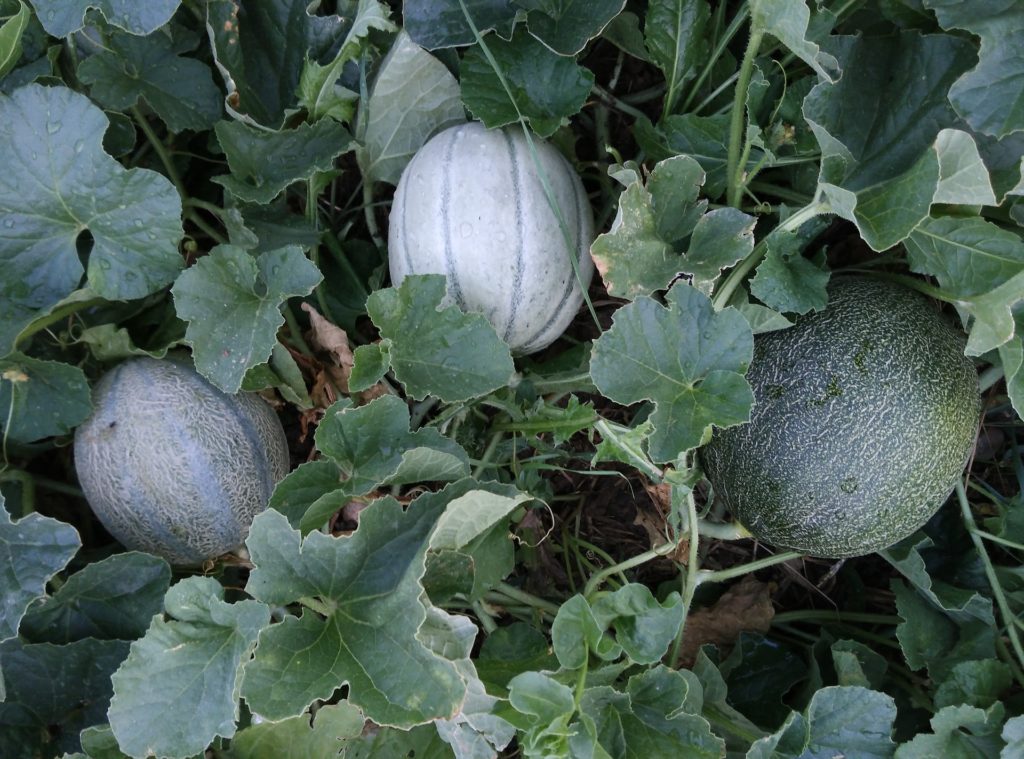
Melons are sweet, refreshing fruits that flourish in California’s warm climate. May is the ideal time to plant watermelon and cantaloupe seeds when the soil is warm and daytime temperatures are consistently above 70°F. Choose a sunny, well-drained area for planting, and prepare the soil by incorporating organic matter. Directly sow seeds about 1-2 inches deep and space them 3-5 feet apart to ensure adequate room for their sprawling growth. Keep the soil consistently moist during germination and early fruit development, then reduce watering as they mature. Regular monitoring for pests is key to enjoying a bountiful harvest of your favorite melons.
Varieties: Popular choices include cantaloupe, watermelon, and honeydew.
Soil Preparation: Melons thrive in rich, fertile soils with solid drainage.
Spacing Recommendations: Space seeds 3-5 feet apart, depending on variety.
Watering Needs: Keep soil consistently moist during early growth, tapering off as melons mature.
Pest Management: Monitor for pests like aphids and cucumber beetles.
Harvesting Tips: Harvest fruits when they are mature and the skin is dull, checking for degree of sweetness.
Peaches
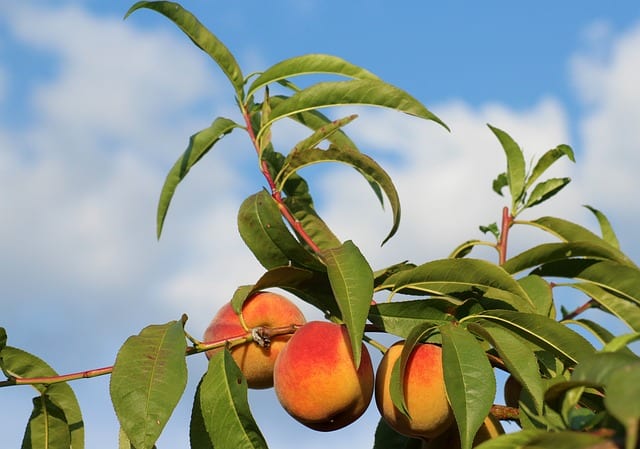
Peach trees are a great addition to Californian gardens, providing delicious fruit that thrives in the state’s climate. May is ideal for planting bare-root or container-grown peach trees, as the soil warms up and frost risk decreases. Choose a well-draining location with fertile soil; amendments like compost can help support healthy growth. Space peach trees 10-15 feet apart to ensure room for canopy growth. Regular deep watering is vital during establishment; as the tree matures, reduce watering frequency while ensuring it remains well-hydrated during fruit development. Prune annually in late winter to promote healthy growth and optimal fruit production.
Varieties: Focus on varieties suited to your local climate and soil conditions; choose either freestone or clingstone peaches.
Soil Preparation: Peaches thrive best in rich, well-drained soils.
Spacing Guidelines: Space trees 10-15 feet apart for ample airflow and growth potential.
Watering Needs: Young trees require regular watering; reduce frequency as they mature.
Fertilization Strategy: Use balanced fertilizers to promote healthy growth and ample fruit production.
Harvesting Timing: Harvest peaches when they are firm but yield slightly to pressure, marking optimal ripeness.
Apples
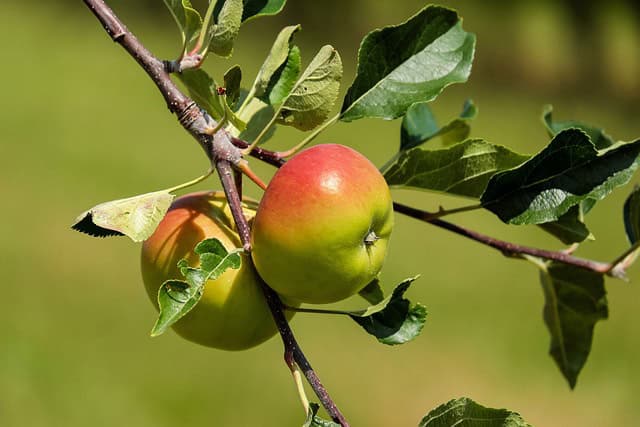
Apple trees can thrive in many regions of California and can yield generous harvests when planted in May. Opt for healthy, well-nourished nursery trees, planting them in rich, well-drained soil with full sun exposure. Space them 15-20 feet apart, depending on the rootstock, to allow adequate airflow and room for growth. Regular deep watering is vital during establishment; as the tree matures, adjust based on rainfall and soil moisture. Utilize appropriate fertilizers during rapid growth phases, and regular pruning in winter will help maintain shape and encourage fruitful harvests.
Varieties: Select from a variety of apple types suited to your climate, such as Granny Smith, Fuji, or Gala.
Soil Preparation: Apples prefer well-drained soils with plenty of organic material.
Spacing Guidelines: Space trees according to their rootstock; typically, 15-20 feet apart.
Watering Needs: Young trees need consistent watering; mature trees can tolerate some drought.
Fertilization Strategy: Apply balanced fertilizers to promote healthy development and fruit yield.
Harvesting Tips: Monitor fruit color and firmness; harvest once apples are mature.
Avocados

Avocado trees are immensely popular in California, known for their creamy fruit. May is a suitable time to plant avocado trees, ideally selecting varieties that suit the local microclimate. Choose a well-drained area, as avocados dislike wet feet, and prepare the soil with organic material if necessary. Space trees 10-15 feet apart to allow for growth and airflow. Water the trees thoroughly upon planting, then regularly but deeply, allowing the soil to dry out slightly between waterings. Protect the tree from harsh winds and consider mulching to maintain moisture levels and improve soil quality.
Varieties: Choose from popular varieties such as Hass, Fuerte, or Bacon based on climate and taste preference.
Soil Preparation: Avocados require well-drained soils to prevent root rot; add compost if necessary.
Spacing Guidelines: Place trees 10-15 feet apart for proper airflow and growth.
Watering Needs: Regular watering is crucial during the establishment phase; mature trees can manage with less.
Fertilization Strategy: Use organic fertilizers to encourage healthy growth and fruit production.
Harvesting Tips: Harvest avocados when they mature; they will soften after being picked.
Figs
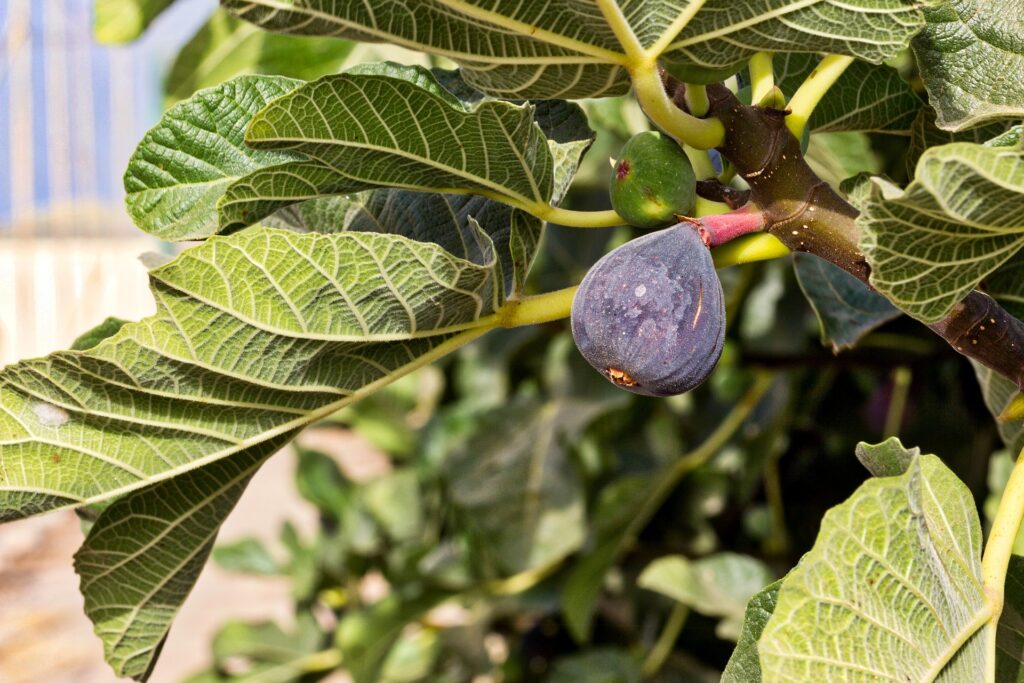
Fig trees are a resilient choice for gardeners, as they require minimal maintenance once established. Planting in May allows figs to benefit from the consistent warmth of California summers. Choose a location with well-drained, fertile soil hitting midday sun, as figs thrive with ample warmth and light exposure. Space trees 10-15 feet apart, allowing for their expansive reach. Water regularly during establishment, tapering off once the tree matures, as figs demonstrate impressive drought resistance. Prune minimally to shape the tree and encourage fruitful branches, enjoying delicious fresh figs in no time.
Varieties: Consider popular varieties like Black Mission or Kadota, which thrive in California conditions.
Soil Preparation: Figs prefer deep, well-draining fertile soils that retain adequate moisture.
Spacing Guidelines: Space trees about 10-15 feet apart for good airflow.
Watering Needs: Young trees require regular watering; reduce frequency once established.
Fertilization Strategy: Minimal fertilization is usually necessary; amend periodically if soil is poor.
Harvesting Timing: Harvest ripe figs when they’re plump and soft, typically in late summer.
Herbs To Plant
Herbs can add flavor while providing an aromatic experience in your garden. They are often easy to grow and can thrive in pots or garden beds. Here are garden-centric considerations:
Basil
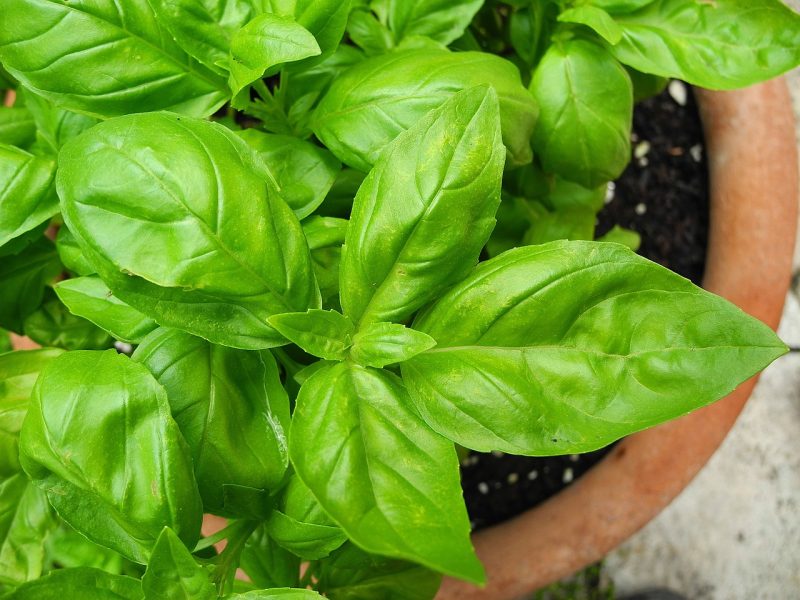
Basil is a staple herb that flourishes in the warm temperatures of May, making it a fantastic choice for early summer cultivation. When planting basil, choose a sunny spot with well-draining soil, ideally enriched with organic matter. Space seedlings or seeds about 12 inches apart and plant about 1/4 inch deep. Regularly watering basil to maintain consistent moisture is key, especially during dry periods. Avoid getting water on leaves to prevent disease. Frequent harvesting encourages a bushier plant and prevents flowering, ensuring a continuous supply of fresh basil for culinary use.
Varieties: Select sweet basil, Thai basil, or purple basil based on culinary uses.
Soil Preparation: Basil does best in rich, well-drained soils that retain moisture.
Spacing Recommendations: Space seedlings 12-18 inches apart for proper growth.
Watering Needs: Keep the soil evenly moist; adjust watering based on rainfall and temperature.
Pest Management: Monitor for aphids and thrips, addressing any infestations promptly.
Culinary Uses: Use fresh in sauces, salads, and as a flavor enhancer for various dishes.
Rosemary
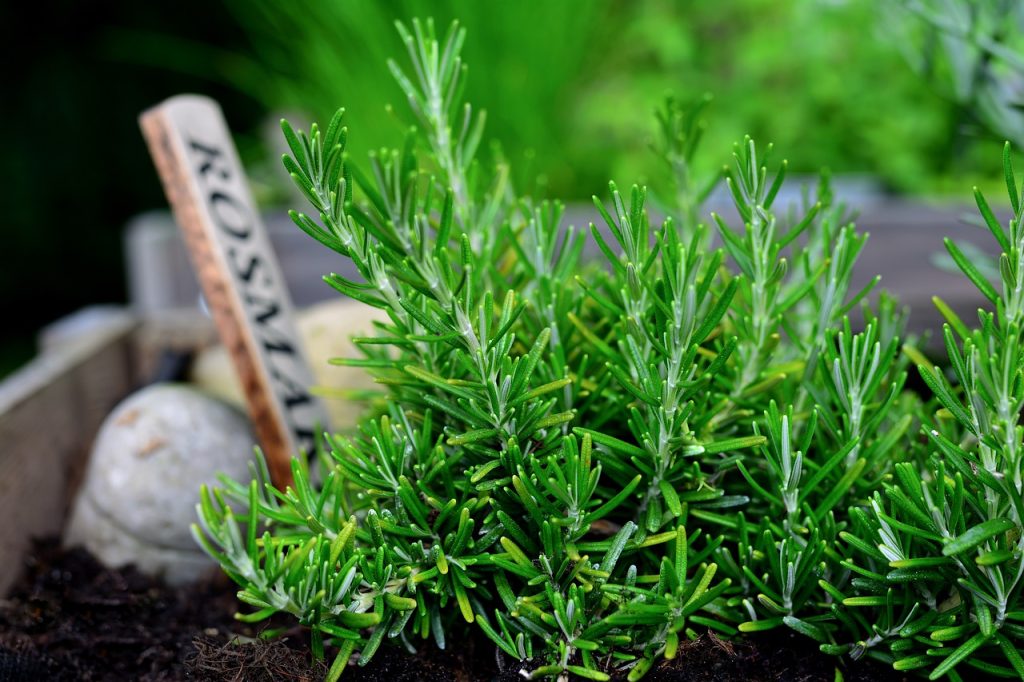
Rosemary is a fragrant and versatile herb that thrives well in California’s dry climate. May provides an excellent opportunity to plant rosemary, as warmer temperatures enhance growth. Choose a sunny outdoor area with well-drained soil, as rosemary prefers sandy, rocky spaces. Space plants between 2-3 feet apart to allow for their natural spreading habit. After planting, water sparingly to avoid root rot—rosemary is drought-resistant once established. Regular pruning can stimulate denser foliage while enhancing flavor for culinary uses.
Varieties: Consider traditional varieties like ‘Tuscan Blue’ or trailing varieties for containers.
Soil Conditions: Prefers well-drained sandy or rocky soils that promote proper drainage.
Spacing Recommendations: Space plants at least 2-3 feet apart for good airflow.
Watering Needs: Water sparingly; rosemary is drought-tolerant once established.
Culinary Uses: Use fresh or dried in various dishes like roast meats, breads, and stews.
Pest Resistance: Generally resistant to pests and disease; however, watch for spider mites.
Thyme
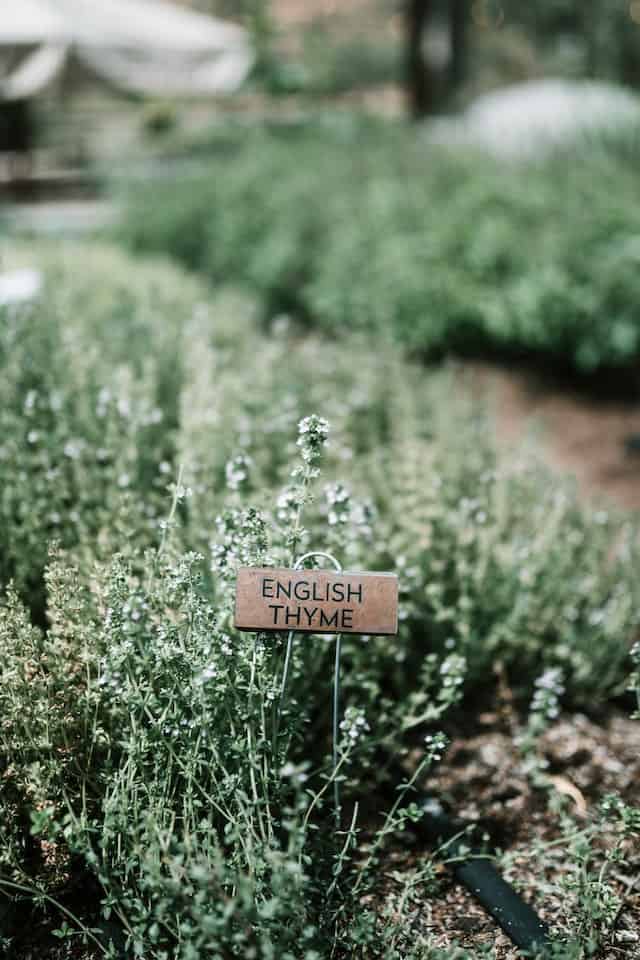
Thyme is an incredibly resilient herb that thrives in the dry, warm conditions of California. May is the ideal time to plant thyme in a sunny area with well-draining soil, which is crucial for preventing root rot. Space seedlings or seeds about 12 inches apart, as thyme can spread over time. Water regularly during establishment, keeping the soil slightly moist but allowing it to dry out between watering sessions; thyme is quite drought-tolerant once established. Regularly harvesting thyme promotes bushier growth, enhancing its culinary flavor.
Varieties: Choose from common varieties like English thyme or lemon thyme for added flavor in dishes.
Soil Preferences: Thyme thrives in loose, well-drained soils; avoid heavy clay.
Spacing Recommendations: Space seedlings 12 inches apart to allow for growth.
Watering Needs: Maintain slightly moist soil during establishment; reduce once established.
Culinary Uses: Use fresh or dried thyme to season meats, vegetables, and soups.
Pest Management: Generally pest-resistant; monitor for aphids or spider mites occasionally.
Oregano
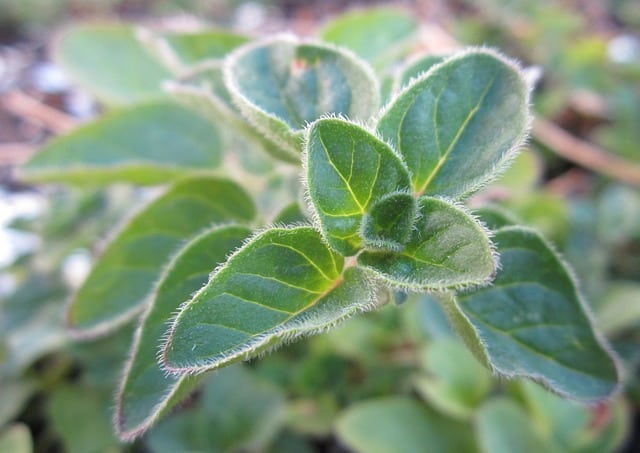
Oregano is a robust, easy-to-grow herb that is a favorite in many kitchens. Planting in May is favorable, as oreganos thrive in warmer temperatures. Choose a sunny spot with well-drained soil, as oregano can adapt to poorer soils. Space plants around 12-18 inches apart, ensuring good airflow. Water regularly when young, then reduce as the plants mature to prevent excessive moisture. Pruning regularly will encourage fresh growth and flavorful leaves, as oregano is a key herb in Mediterranean dishes.
Soil Conditions: Prefers well-drained, relatively poor soils that are not overly rich.
Spacing Options: Space plants 12-18 inches apart to avoid overcrowding.
Watering Needs: Water when young; mature oregano tolerates dry conditions well.
Culinary Uses: Use fresh leaves in sauces, salads, and meat dishes.
Pest Management: Generally pest-resistant; maintain overall plant health to avoid issues.
Harvesting Tips: Regularly snip leaves for culinary use to promote growth.
Chives
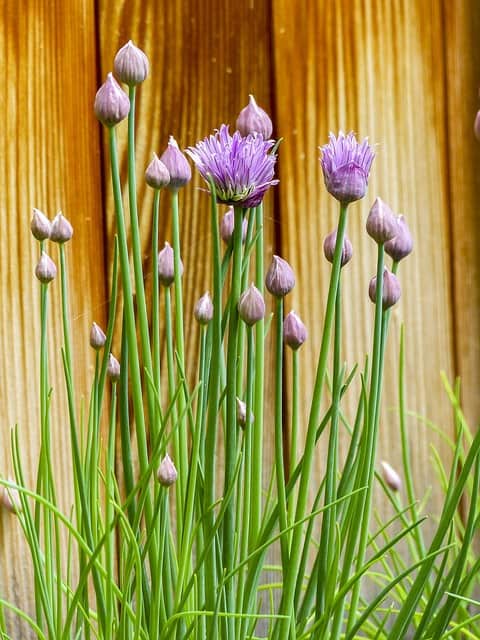
Chives offer a mild onion flavor that enhances a variety of dishes. May is an excellent time to plant chive seeds or divides bunches in well-drained, fertile soil. Choose a sunny or slightly shaded spot in your garden. Space clusters about 10-12 inches apart to allow for growth. Keep the soil consistently moist during establishment for optimal sprouting; once established, chives show some drought tolerance. Regularly trimming back leaves will result in bushier growth while providing fresh chives for your kitchen.
Soil Conditions: Chives thrive in nutrient-rich, well-drained soils.
Spacing Suggestions: Space plants about 10-12 inches apart to accommodate growth.
Watering Needs: Keep soil consistently moist during establishment; mature plants tolerate some drought.
Culinary Uses: Use fresh leaves in salads, soups, and as a garnish.
Pest Management: Generally low-maintenance with minimal pest problems; monitor for aphids.
Harvesting Timing: Cut leaves frequently to encourage growth and flavor.
Cilantro
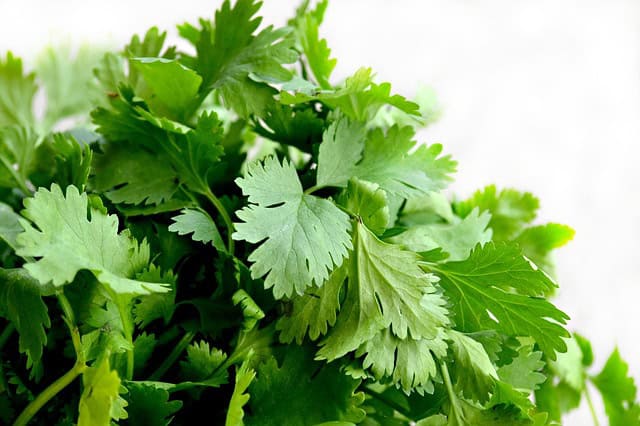
Cilantro is a popular herb for recipes worldwide, known for its bright flavor. May is the ideal time to plant cilantro in well-drained, rich soil that receives full sun. Sow seeds directly into your garden or in pots, covering them lightly to allow sunlight to reach them for proper germination. Water the soil consistently to keep it moist, as cilantro requires ample moisture for optimal growth. Harvest the outer leaves regularly to encourage continuous growth, and consider successively sowing seeds every few weeks to extend your harvest.
Soil Preparation: Cilantro thrives in well-drained, organic-rich soils.
Spacing Recommendations: Space seeds about 6-8 inches apart for proper airflow.
Watering Needs: Keep the soil consistently moist, particularly during germination.
Pest Management: Watch for aphids; address infestations with insecticidal soap if necessary.
Culinary Uses: Use fresh leaves in salsas, salads, and as a garnish for many dishes.
Harvest Timing: Cut and use leaves regularly to encourage further growth and prevent flowering.
Dill
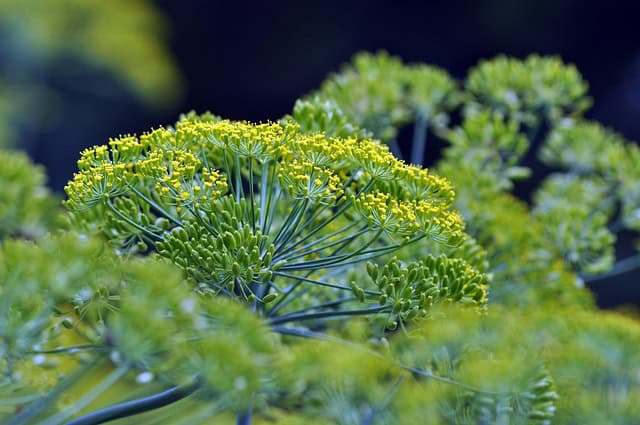
Dill is an aromatic herb often used in pickling and culinary dishes. May presents a perfect opportunity to plant dill seeds directly in well-drained, fertile soil. Choose a sunny location in your garden, as dill thrives in full sun. Space seeds about 10-12 inches apart once they emerge, allowing for adequate airflow. Water regularly during the establishment phase to promote strong root growth, as dill prefers consistently moist soil. As the plants grow, regular harvesting of leaves and flowers will not only enhance flavor but encourage further bushiness.
Soil Needs: Dill prefers well-drained, rich soils for optimal growth.
Spacing Requirements: Allow about 10-12 inches between plants for air circulation.
Watering Needs: Keep the soil evenly moist; dill loves consistent moisture.
Culinary Uses: Use fresh in dishes or for pickling to add flavor.
Pest Monitoring: Dill can attract beneficial insects, helping to control pests naturally.
Harvest Timing: Regularly snip leaves for use; the plant will remain productive with frequent harvesting.
Parsley
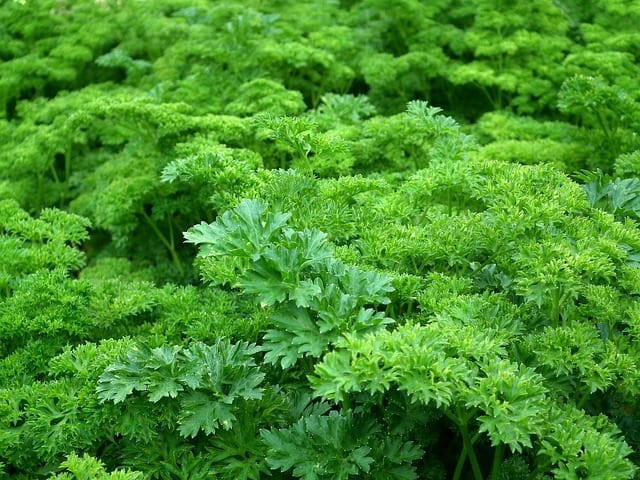
Parsley is a versatile herb that can be grown successfully in May. It thrives in well-drained, fertile soil and prefers a sunny or partially shaded environment. Sow seeds directly into the ground or in containers, covering them lightly; space plants about 10-12 inches apart. Water regularly to keep the soil moist, particularly during germination, which can take 14-21 days. By snipping outer leaves as needed, parsley can have a continuous harvest throughout the growing season, making it a valuable addition to your herb garden.
Soil Preparation: Prefers rich, organic, well-drained soils for optimal growth.
Spacing Recommendations: Space plants 10-12 inches apart for adequate room.
Watering Needs: Keep soil consistently moist during germination and early growth.
Pest Management: Generally resistant to pests, but monitor for issues and address promptly.
Culinary Uses: Widely used as a garnish and for flavoring in numerous dishes.
Harvest Timing: Cut outer leaves regularly to promote new growth and ensure freshness.
Sage
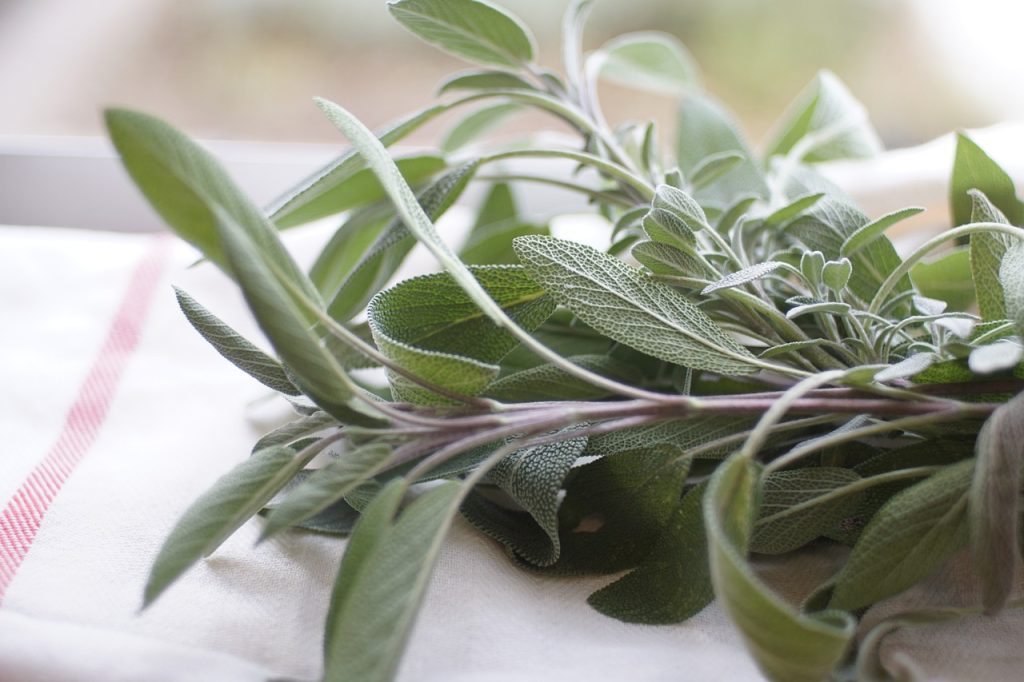
Sage is an aromatic perennial that adds flavor to many dishes. May is suitable for planting sage seedlings in well-drained soil that receives full sunlight. Use sandy or slightly rocky soil, as sage does not prefer overly rich conditions. Space plants about 2-3 feet apart to promote airflow as they grow. Water sparingly, allowing the soil to dry out between waterings; once established, sage is drought-tolerant. Regularly pruning sage will stimulate new growth and help maintain bushiness, ensuring a continuous supply of fragrant leaves for culinary use.
Soil Preparation: Sage prefers sandy or loamy, well-drained soils for optimal growth.
Spacing Options: Space plants about 2-3 feet apart to allow for spread.
Watering Needs: Allow the soil to dry out between waterings; sage prefers less frequent irrigation.
Culinary Uses: Use fresh or dried to enhance meats, sauces, and stuffing.
Pest Management: Sage is relatively pest-resistant but can occasionally be affected by aphids.
Harvest Timing: Trim leaves regularly to encourage bushy growth and intensity of flavor.
Mint
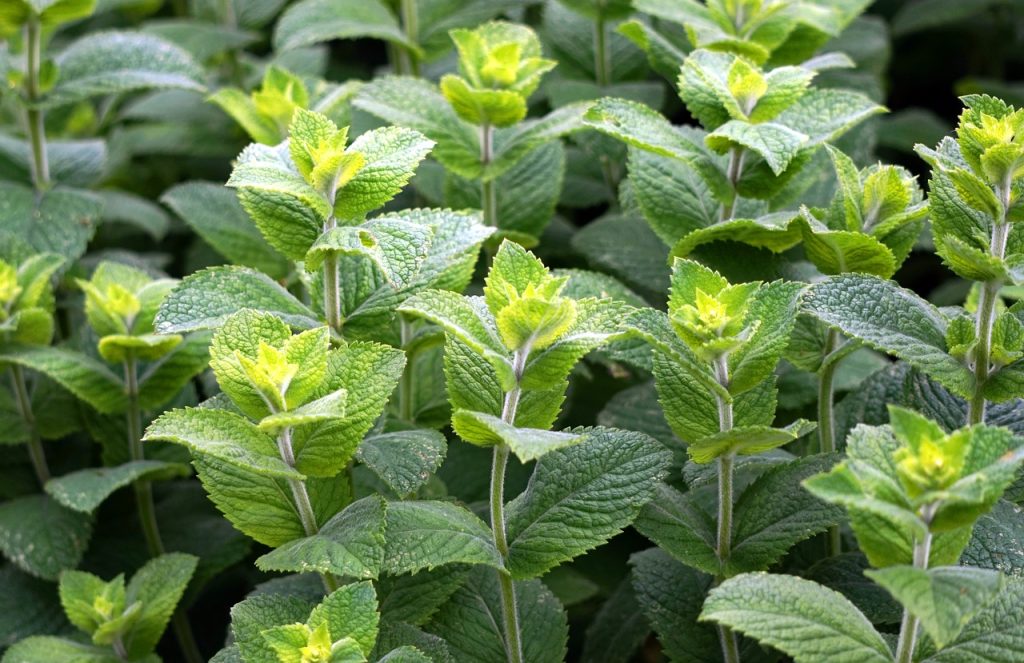
Mint is a vigorous growing herb that can spread rapidly, so it’s often best grown in pots to prevent it from overtaking your garden. May is a perfect time to plant mint in well-drained, rich soil that retains a bit of moisture. Choose a sunny or slightly shaded location, spacing the plants about 12 inches apart to allow for spreading. Water regularly to maintain moisture, especially during dry periods; mint thrives in consistently damp conditions. Regular harvesting encourages bushier growth and ensures a fresh supply of mint for beverages and culinary creations.
Soil Conditions: Mint thrives in rich, well-drained, slightly moist soils.
Spacing Options: Space plants about 12 inches apart to allow spreading.
Watering Needs: Water consistently; mint loves moisture and will wilt if dry.
Sunlight Requirements: Full sun works well, but mint can tolerate partial shade.
Pest Monitoring: Generally pest-resistant, but watch for spider mites and aphids.
Culinary Uses: Fresh mint can be used in teas, cocktails, and desserts, enhancing flavors and aromas.
Landscape Plants To Plant
California gardens can also be visually stunning with beautiful landscape plants. Below are some recommendations to enhance your outdoor spaces in May.
California Native Sage
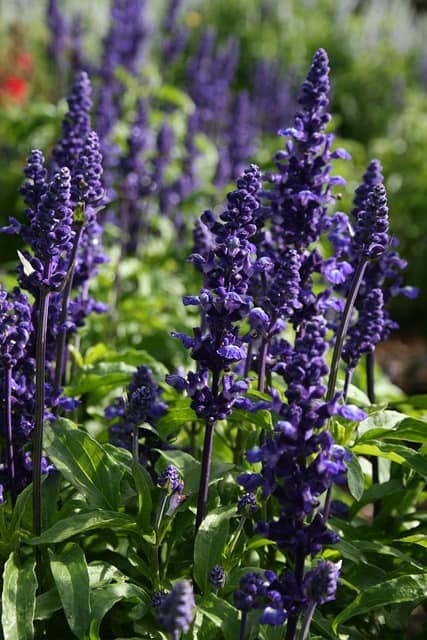
California native sage is an aromatic shrub well-suited for the state’s climate. Planting in May allows this drought-tolerant plant to establish roots before the peak summer heat. Choose a sunny location with sandy, well-drained soil to enhance growth. Space plants 3-5 feet apart to allow for their full height and spread. Water regularly during establishment, but native sage will perform well with little care once it’s rooted. Pruning after flowering will encourage bushiness and maintain an attractive shape, making it a lovely addition to xeriscapes.
Soil Requirements: Prefers well-drained, sandy soils; native sage is tolerant of poor soil conditions.
Spacing Recommendations: Space plants adequately to permit growth without overcrowding.
Watering Needs: Minimal watering is needed once established; water during dry spells or hot weather.
Sunlight Conditions: Full sunlight supports optimal growth; they thrive in warm conditions.
Wildlife Benefits: Provides habitat and food for local pollinators, enhancing biodiversity.
Maintenance Needs: Prune annually to maintain size and shape.
Native Buckwheat

Buckwheat is a hardy native plant used for soil stabilization and attracting pollinators. May is a great time to sow buckwheat seeds directly into prepared garden beds. Choose dry, well-drained soil; this plant thrives in poor soil conditions that may be unsuitable for other plants. Space seeds according to package recommendations, typically 12-18 inches apart, to promote healthy growth. This drought-tolerant plant requires minimal watering once established. Consider allowing some flowers to go to seed to maintain a wildlife-friendly garden that sustains beneficial insects.
Soil Preparation: Buckwheat thrives in poor, well-drained soils with minimal fertility.
Planting Technique: Sow seeds directly into prepared beds, covering lightly for germination.
Sunlight Requirements: Prefers full sun for best growth and flowering.
Watering Needs: Minimal watering is required once plants are established; they are drought-resistant.
Wildlife Attraction: Great for attracting bees and butterflies, promoting biodiversity.
Post-Bloom Care: Save some seeds from blooming plants to encourage self-seeding.
Yarrow
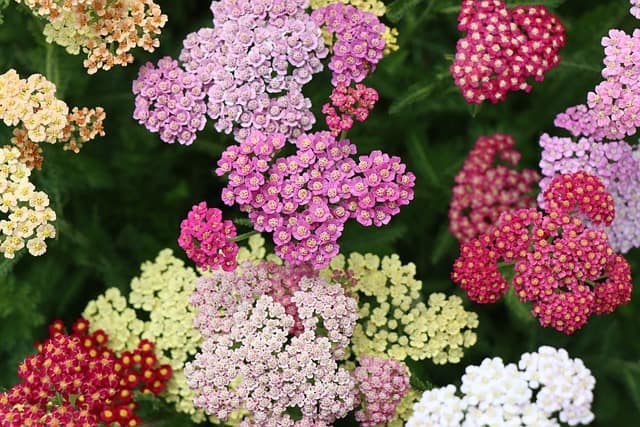
Yarrow is a hardy perennial known for its charming flower clusters and drought resistance. May is an ideal time to plant yarrow seeds or transplants in well-drained sandy or loamy soils. Choose a sunny spot in your garden; yarrow thrives with at least 6 hours of direct sunlight daily. Space plants 12-18 inches apart to allow for spreading and airflow. Once established, this plant requires little water, making it suitable for low-maintenance landscapes. Deadhead spent blooms to encourage a more extended flowering season, helping to attract beneficial pollinators to your garden.
Soil Conditions: Yarrow prefers well-drained sandy or loamy soils; it thrives in drier conditions.
Spacing Recommendations: Space plants 12-18 inches apart to allow for their spread.
Watering Needs: Once established, yarrow is drought tolerant; may need watering during prolonged dry spells.
Sunlight Conditions: Flourishes in full sun for optimal blooming.
Beneficial Insect Attraction: Yarrow is excellent for attracting pollinators like bees and butterflies, enhancing biodiversity in your garden.
Harvesting Tips: Cut back spent flowers to encourage new blooms and preserve plant health.
Red Hot Poker
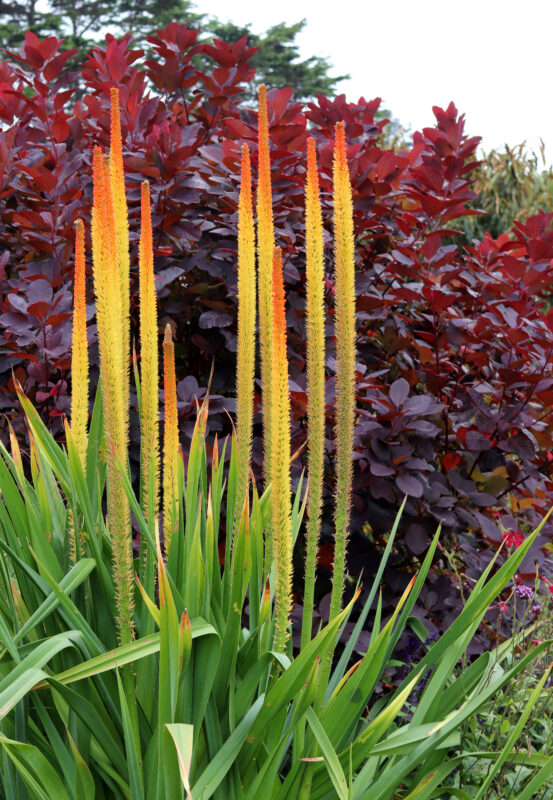
Red Hot Poker, also known as Kniphofia, is a striking perennial with vibrant, torch-like flowers that appear in the summer. May is an excellent time to plant these perennials in well-drained soil with full sunlight. Choose a sunny location, as Red Hot Poker thrives in bright conditions. Space plants about 1-3 feet apart to allow for their mature spread. Water the plants regularly during establishment; once established, they are quite drought-tolerant. Deadhead spent flowers to promote new growth and prolong the flowering season.
Soil Preparation: Prefers well-drained soils; avoid overly rich conditions as they thrive in lean soil.
Spacing Options: Space plants 1-3 feet apart, depending on their variety and expected growth.
Watering Needs: Regular water is crucial during the establishment phase; reduce thereafter.
Pest Monitoring: Generally resistant to pests; however, keep an eye out for aphids and spider mites.
Wildlife Benefits: Attracts hummingbirds and other pollinators with its vibrant flowers.
Maintenance Requirement: Cut back dead foliage in late fall to encourage healthy growth in spring.
Agave
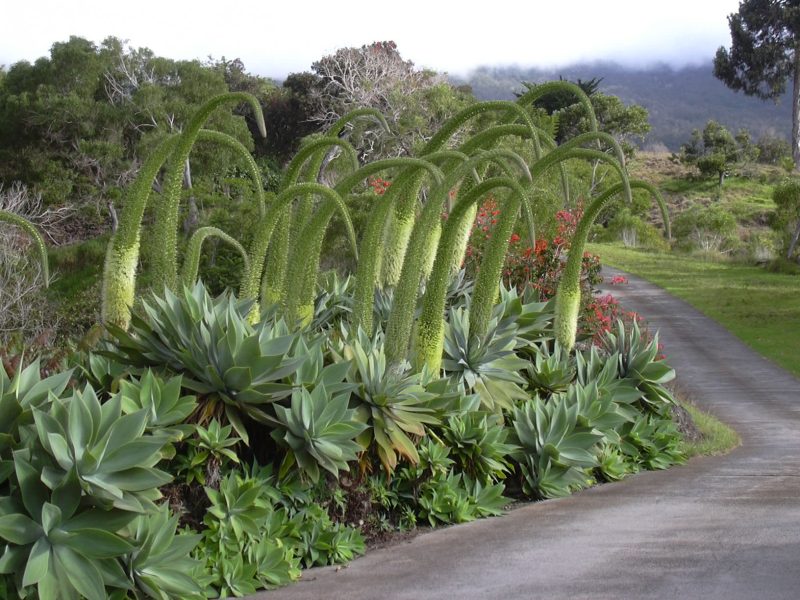
Agave is a striking succulent that is perfect for xeriscaping, requiring minimal water and maintenance. Planting in May allows the agave to acclimatize during the warm months. Use well-draining soil and select a sunny spot, as Agave loves full sun. Space plants at least 3-5 feet apart to accommodate their large size and spiny edges. Water sparingly; agave thrives in dry conditions, making it an excellent choice for low-water landscapes.
Soil Conditions: Prefers dry, sandy, and well-drained soils.
Spacing Recommendations: Space plants 3-5 feet apart to allow for growth and prevent overcrowding.
Watering Needs: Minimal watering required; allow soil to dry out completely between waterings.
Pest Management: Watch for mealybugs and scale insects; treat infestations with insecticidal soap.
Aesthetic Appeal: Add interest to the landscape with their unique shapes and striking foliage.
Harvesting Uses: Some species may be harvested for culinary or beverage use, like making tequila from Agave tequilana.
Lavender Cotton
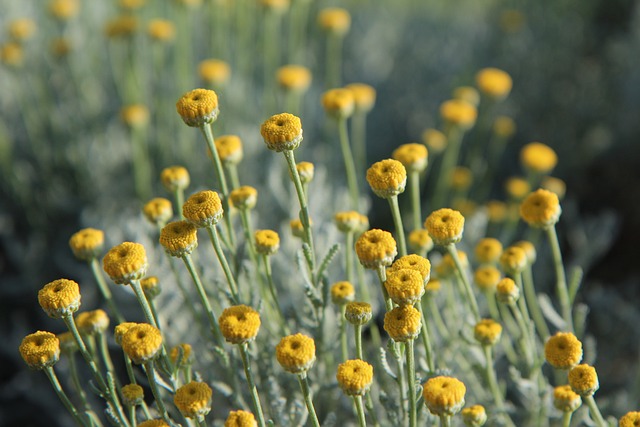
Lavender cotton, or Santolina, is a low-growing perennial known for its fragrant golden foliage and small yellow button-like flowers. May is a favorable time to plant lavender cotton since it thrives in warm weather. Choose well-draining, sandy soil and a sunny location. Space plants about 12-18 inches apart to allow for their spreading growth. Water regularly during the establishment phase; once established, they can tolerate drought conditions. Pruning after flowering helps maintain shape and encourage new growth, making it a lovely addition to borders or rock gardens.
Soil Preparation: Prefers well-drained, sandy soils with minimal organic matter.
Spacing Options: Space plants 12-18 inches apart to allow their spread.
Watering Needs: Regular watering during establishment; reduce as they acclimate to conditions.
Harvesting Tips: Can be trimmed for aesthetic purposes or to create fragrant sachets.
Wildlife Attraction: Attracts bees and other pollinators, enhancing garden biodiversity.
Post-Bloom Care: Trim back spent flowers and foliage to encourage healthy growth in the following season.
Hummingbird Sage
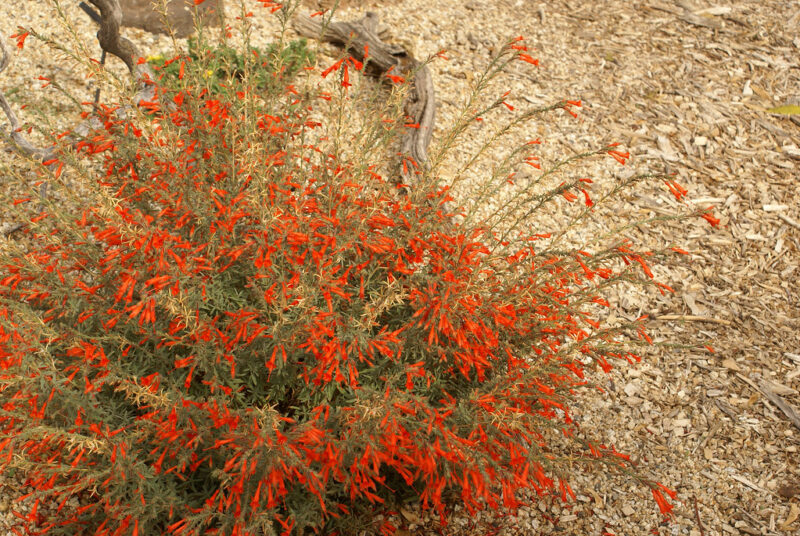
Hummingbird sage, or Salvia spathacea, is a favorite among pollinators due to its vibrant purple flowers. May is an excellent planting time for this native California plant. Choose a sunny location with well-drained soil to plant salvia. Space plants about 18-24 inches apart, as they can spread significantly. Water regularly during the establishment phase, but once established, they are relatively drought-tolerant. Prune after flowering to maintain a tidy shape and encourage new blooms for the next season.
Soil Conditions: Prefers well-drained, sandy or rocky soils.
Spacing Recommendations: Space plants 18-24 inches apart to facilitate airflow and growth.
Watering Needs: Water during establishment, tapering off as plants mature.
Wildlife Benefits: Attracts hummingbirds, bees, and butterflies, contributing to a vibrant ecosystem.
Aesthetic Uses: Effective as a border or in mass plantings for striking visual impact.
Maintenance Strategies: Regular pruning after bloom will enhance flowering in subsequent seasons.





